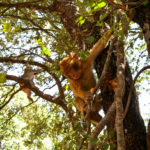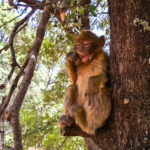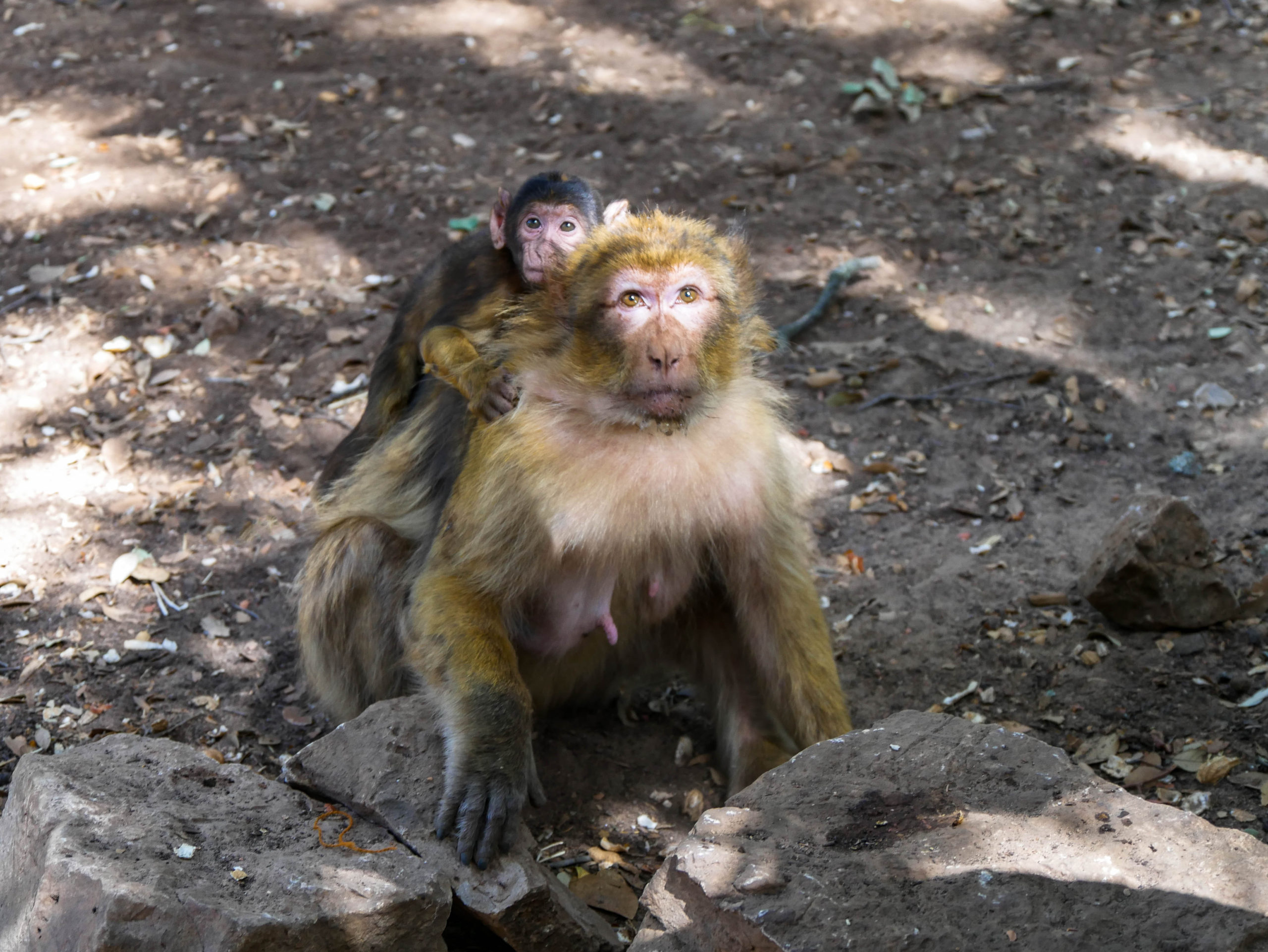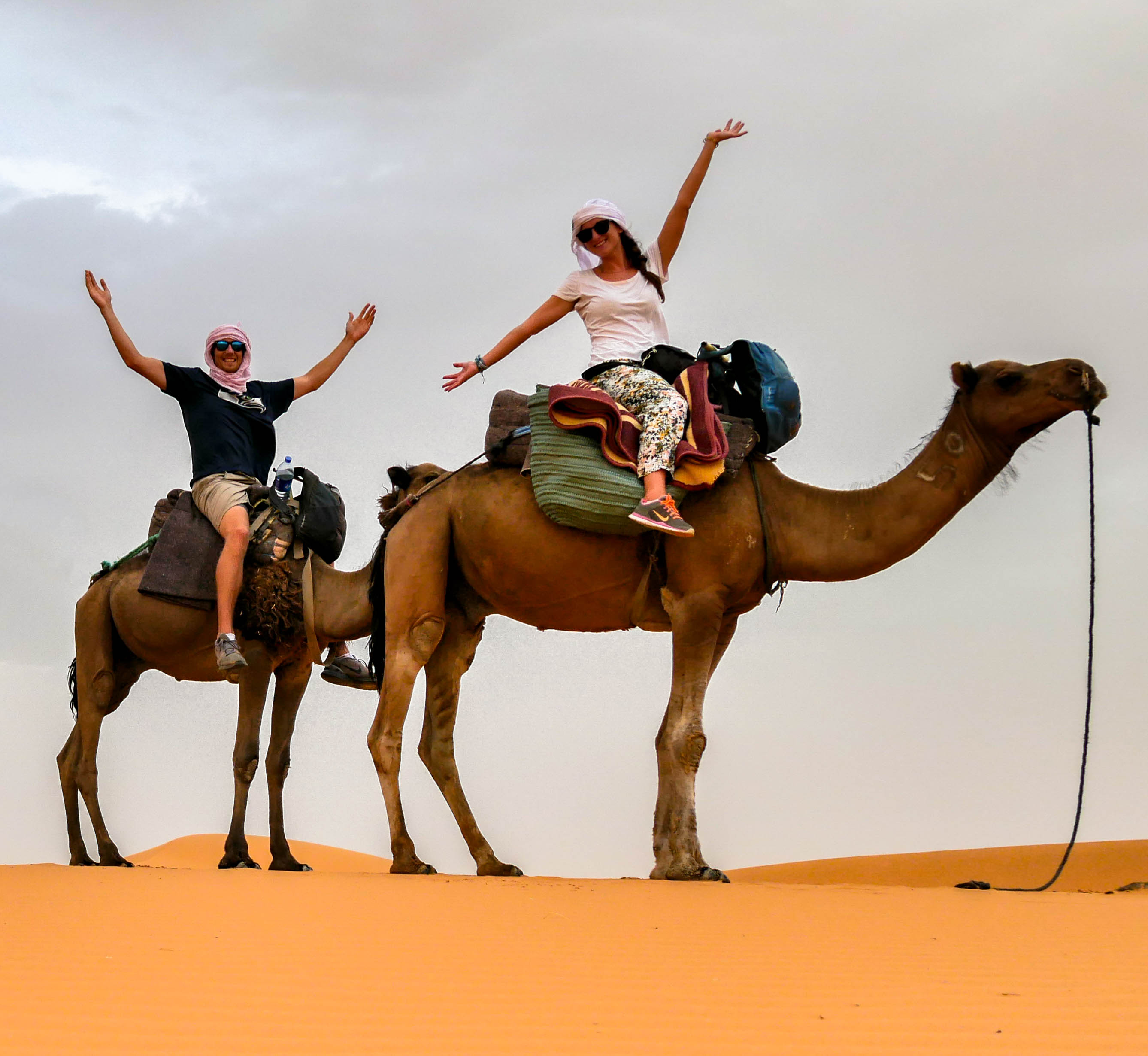
We traveled to Africa with the dream and bucket list item of riding camels through the Sahara Desert.
The coastal African town of Tangier is a short ferry ride from Spain (an hour from Tarifa and only 35 euros with FRS) so we knew we had to jump on the chance to visit the fourth continent and 13th country of our journey. After a day exploring Tangier, taking a train to Fes, and a day trip to the blue city of Chefchoauen, we began a four-day camel trek from Fes to Marrakech.
Day 1: Fes to cedar forests with monkeys to palm groves to the Sahara Desert

We were picked up at our hotel at 8 a.m. by Morocco Camel Trekking to start the drive to the Sahara Desert. After spending a few days in Morocco, getting accustomed to the culture and architecture, our first stop in Ifrane felt out of place.
It was described by our guide as the little Switzerland, because of its alpine style architecture. The architecture was unlike anything we’d seen in Morocco and everything was very well maintained. Apparently, it snows in the winter and that contributes to the different architecture (although it was hard to picture snow here in the summer heat).
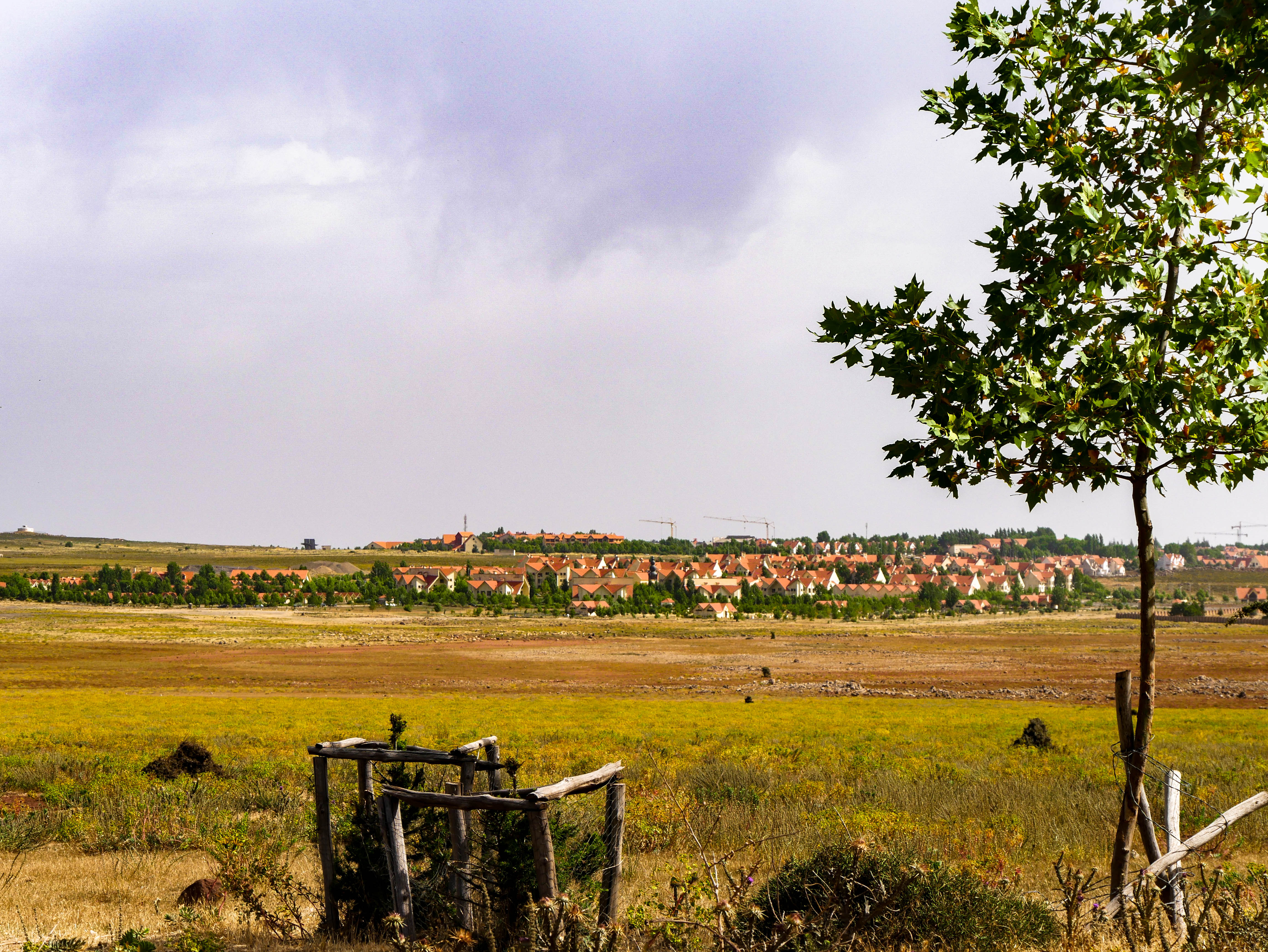
We were told lions used to run free in this area before too many humans inhabited the town.
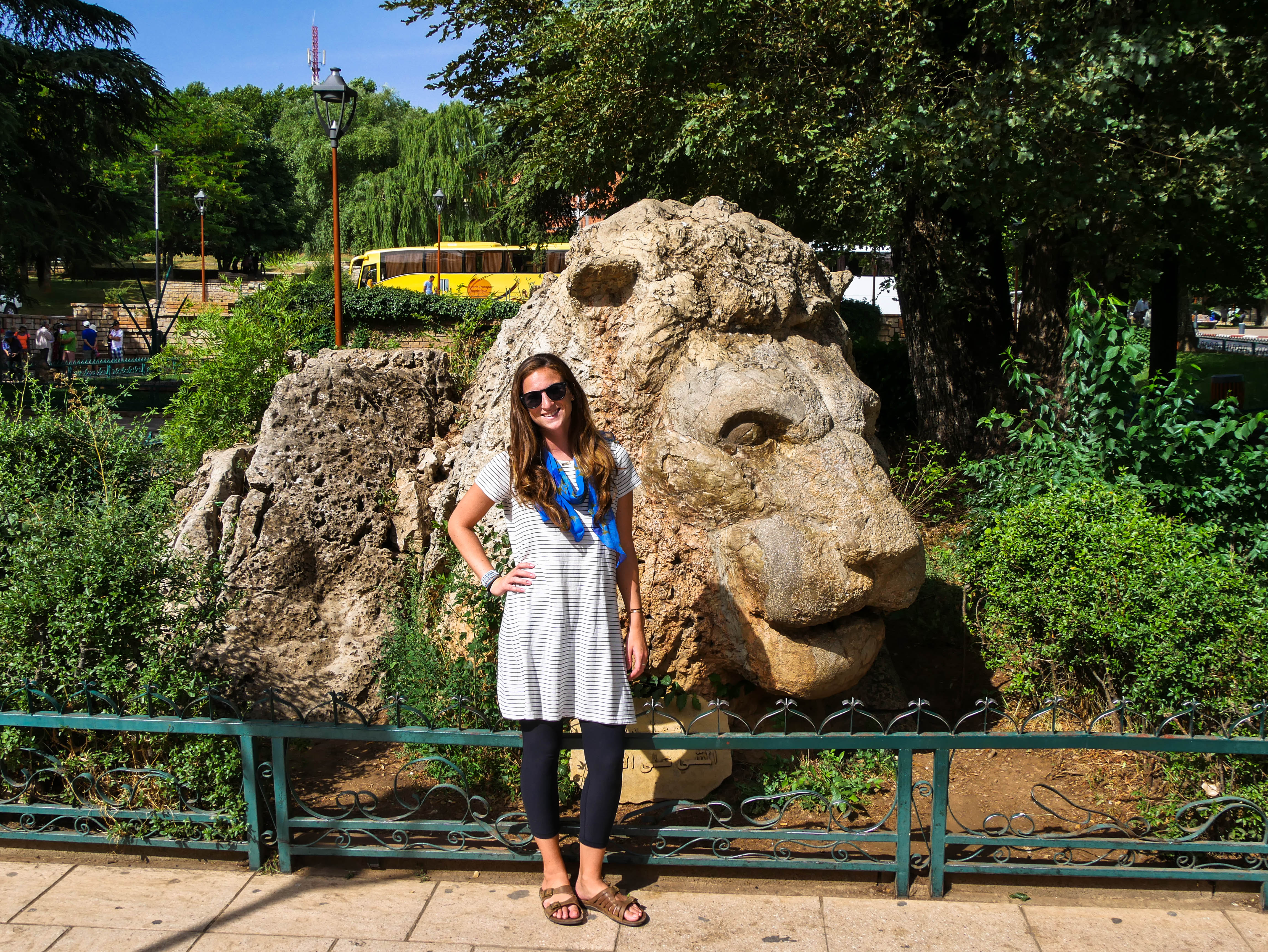
Driving through the cedar forests of Azrou, we were greeted by monkeys on the side of the road. We hopped out of the car and bought peanuts for 5 dirhams (roughly 50 cents in USD) to feed the monkeys. They were adorable, but timid around humans. They would snatch the peanuts out of our hands.
The scenery changed as we drove alongside and above the palm groves.
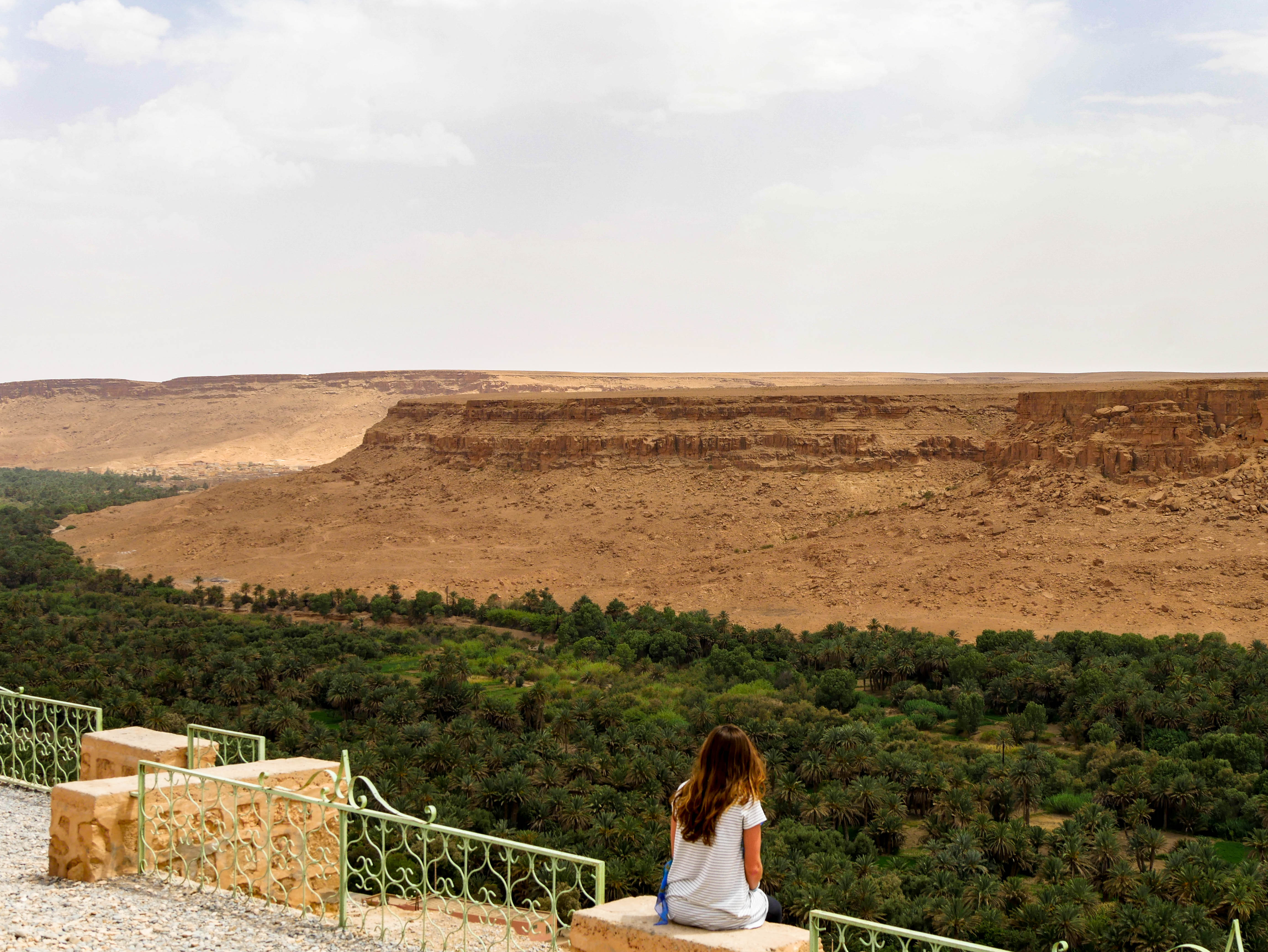
We stopped at a hotel in the palm groves enjoyed a three-course lunch of Moroccan salad (tomatoes, peppers, cucumbers, olives) and tagine (typical Moroccan dish of meat and vegetables served in a ceramic dish), with canary melon and watermelon for dessert.
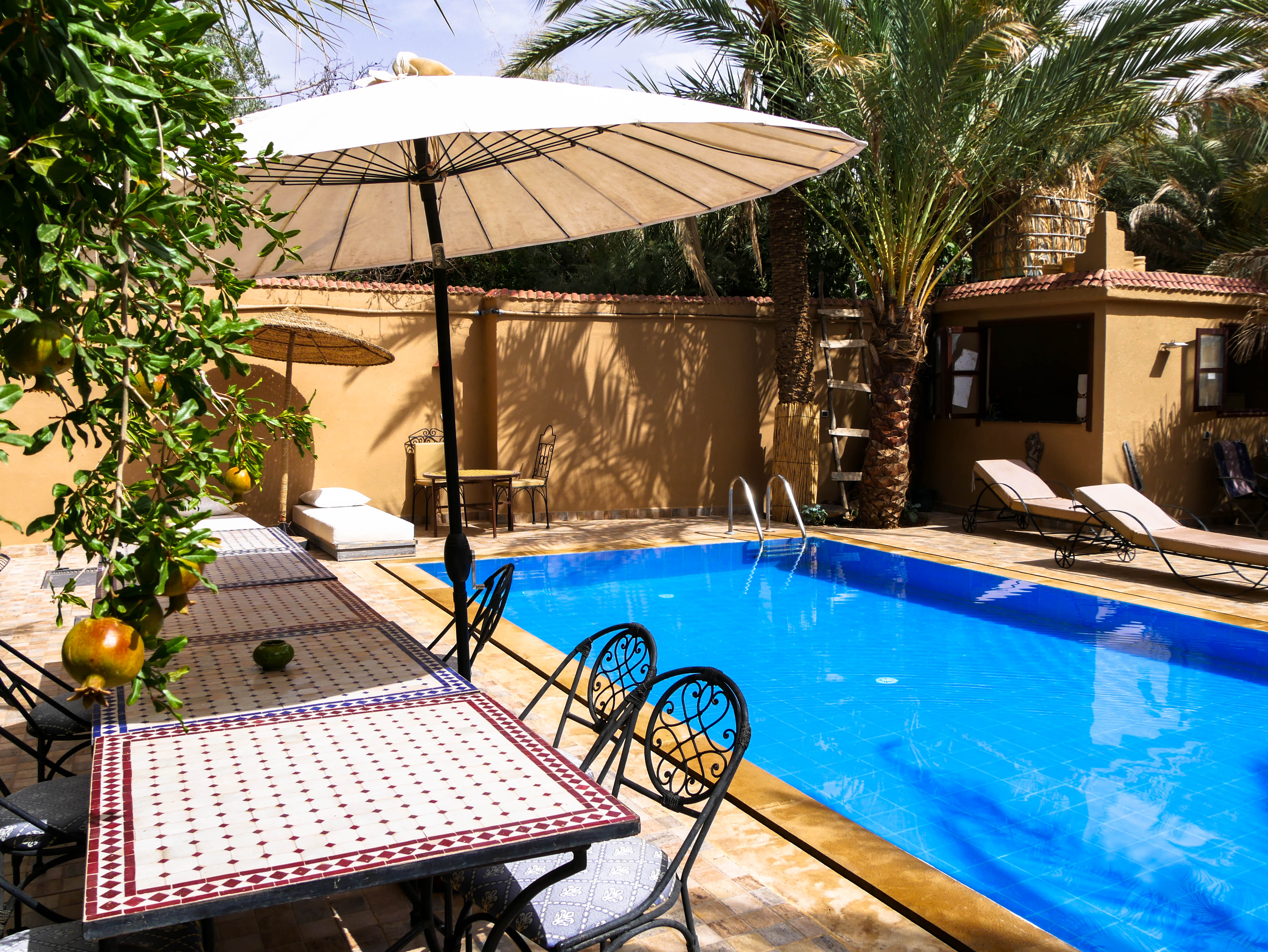
Our guides asked if we wanted to spend two nights in the desert or our first night in the hotel (and second in the desert camp). As the car thermometer read 46 degrees Celsius (118 degrees Fahrenheit) and we didn’t think the camp would have AC (spoiler alert, it didn’t), we opted to spend our first night in a hotel. We were more than pleased with our decision when we arrived at the beautiful Riad Mamouche in Merzouga.
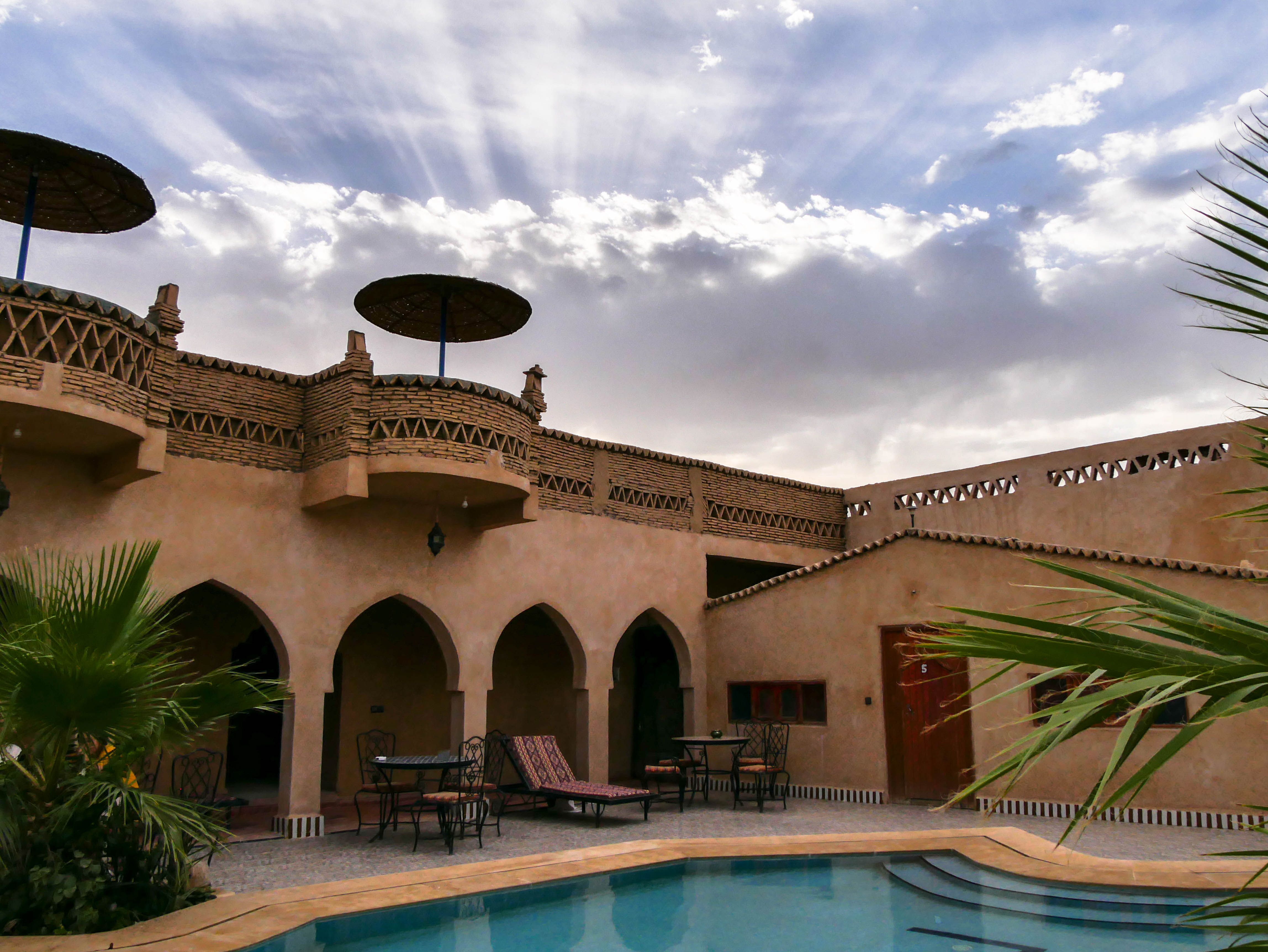
Our room was ginormous and gorgeous! We could’ve easily slept three more people with a second room with two beds. More than anything we were thankful to have air conditioning as the low at night was 90 degrees in the Sahara.
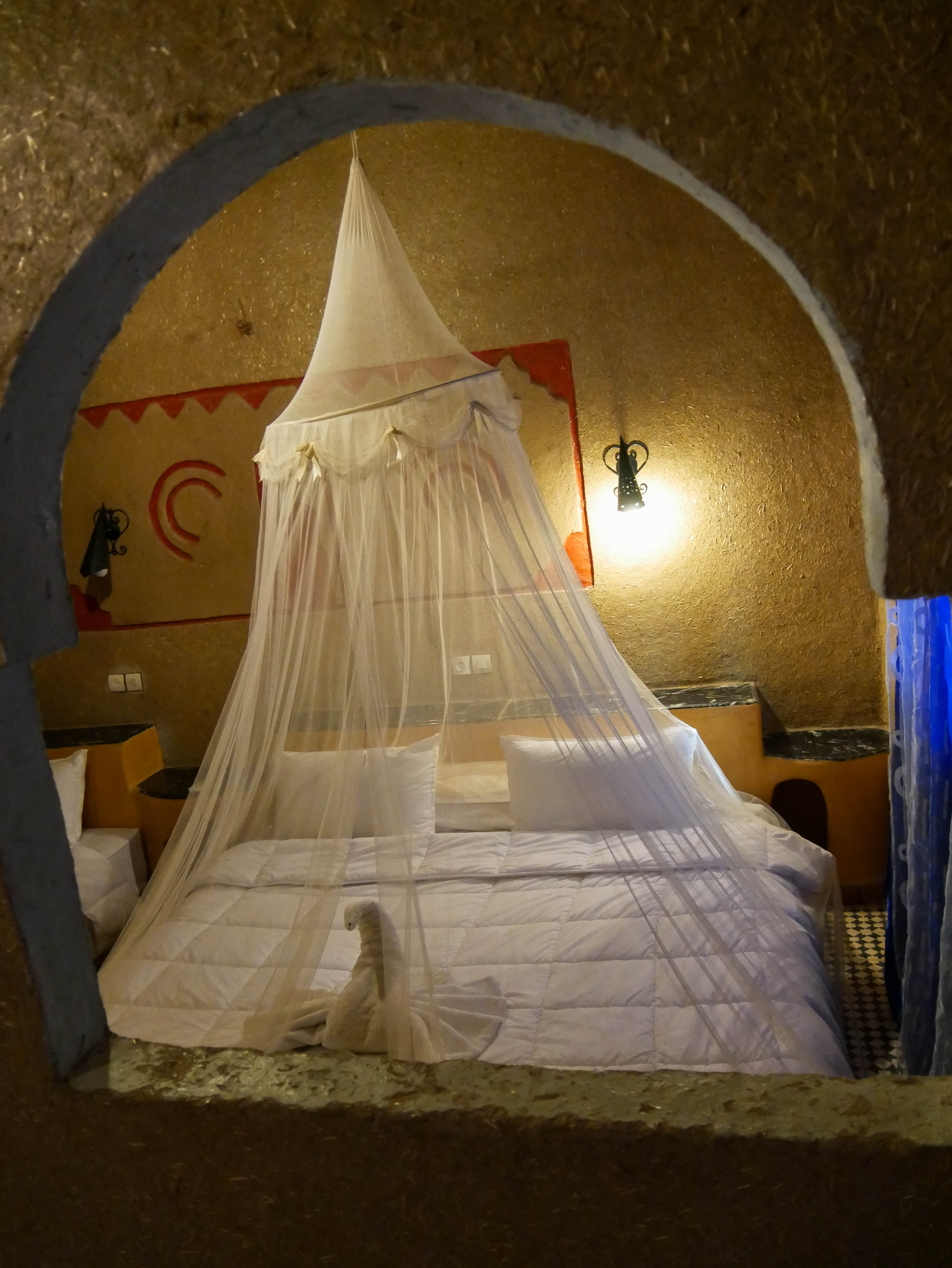
After a traditional Moroccan welcome with mint tea, dried fruits, and nuts, we enjoyed a dip in the pool.
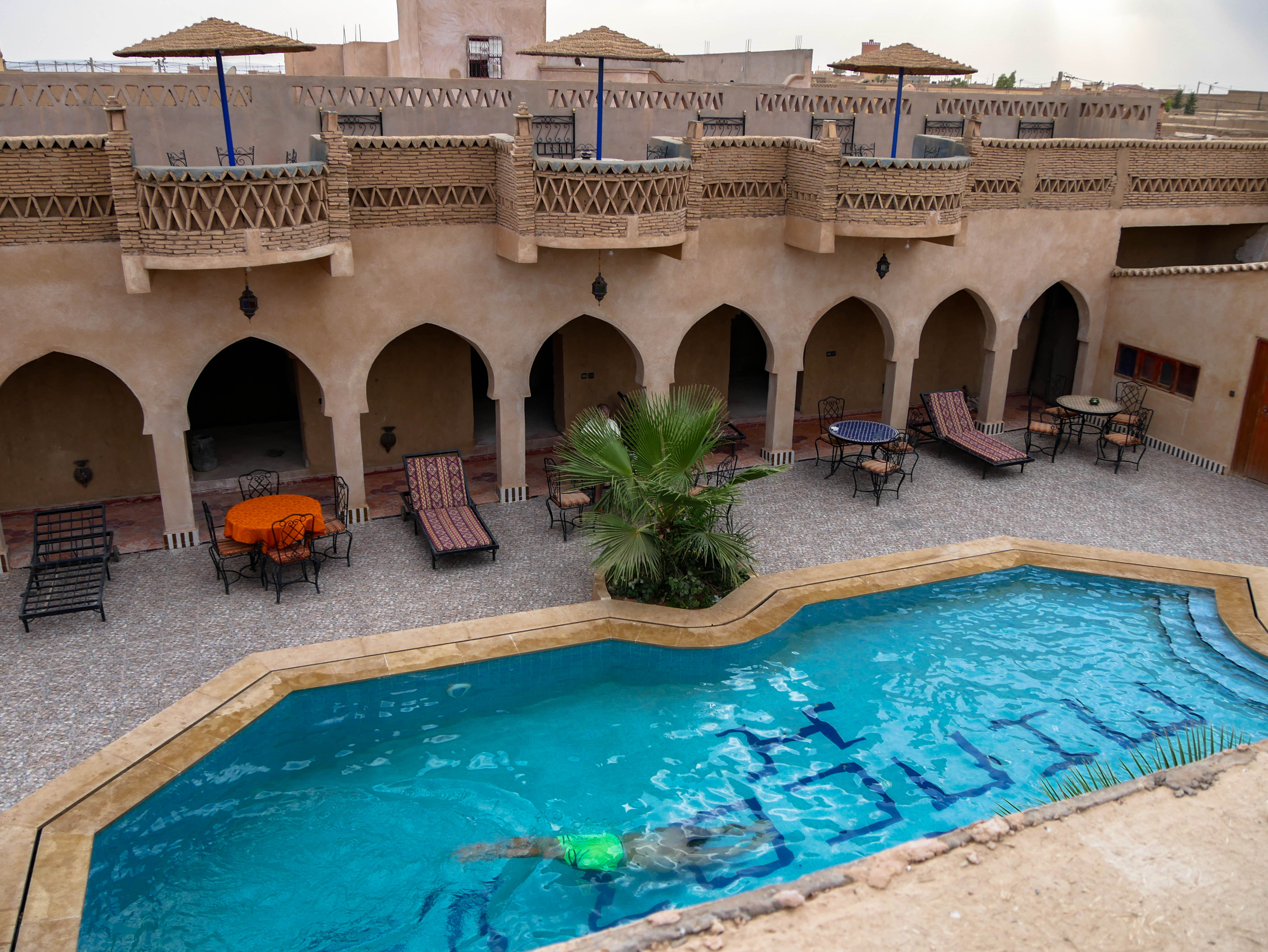
At 7 p.m. the weather cooled off (a bit) and we took a short walk to the dunes in the Sahara desert. We were surprised by how orange the sand was!

We returned to the hotel for dinner at the pool and one more dip in the pool before bed.
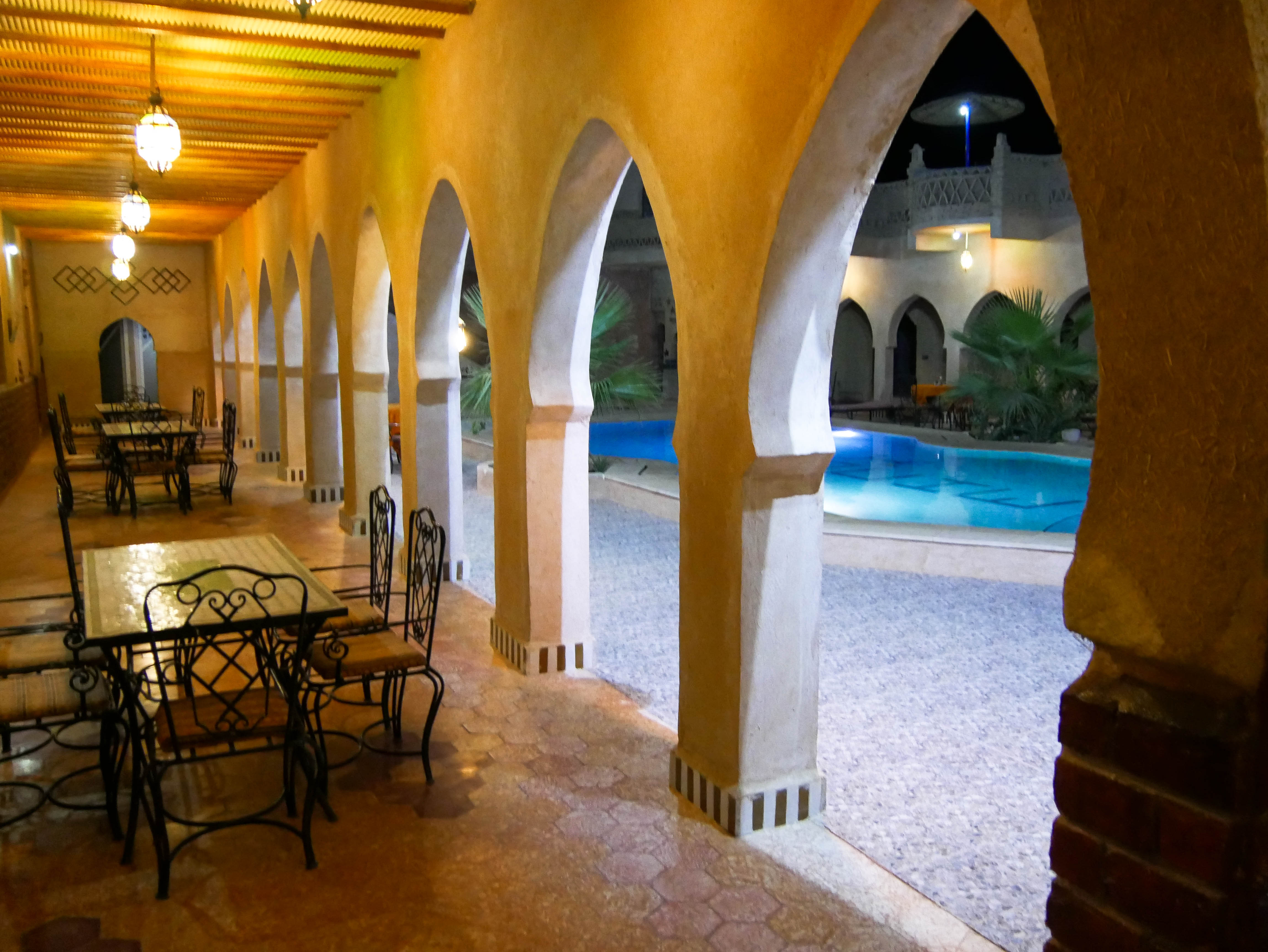
Day 2: 4×4 Tour and Camel Trek in the Sahara Desert
After enjoying a breakfast buffet outside by the pool, we were picked up by our guide Ibrahim, the owner of Morocco Camel Trekking, at 10 a.m.

Ibrahim guided us on a 4×4 tour (with AC!) around the dunes. He pointed out Algeria, the border of a flat mountain visible in the distance, and joked that he was taking us to Algeria, a big grin on his face visible to us from the rear view mirror. In our short time in Morocco, we’ve noted that Moroccans love to make jokes. 🙂
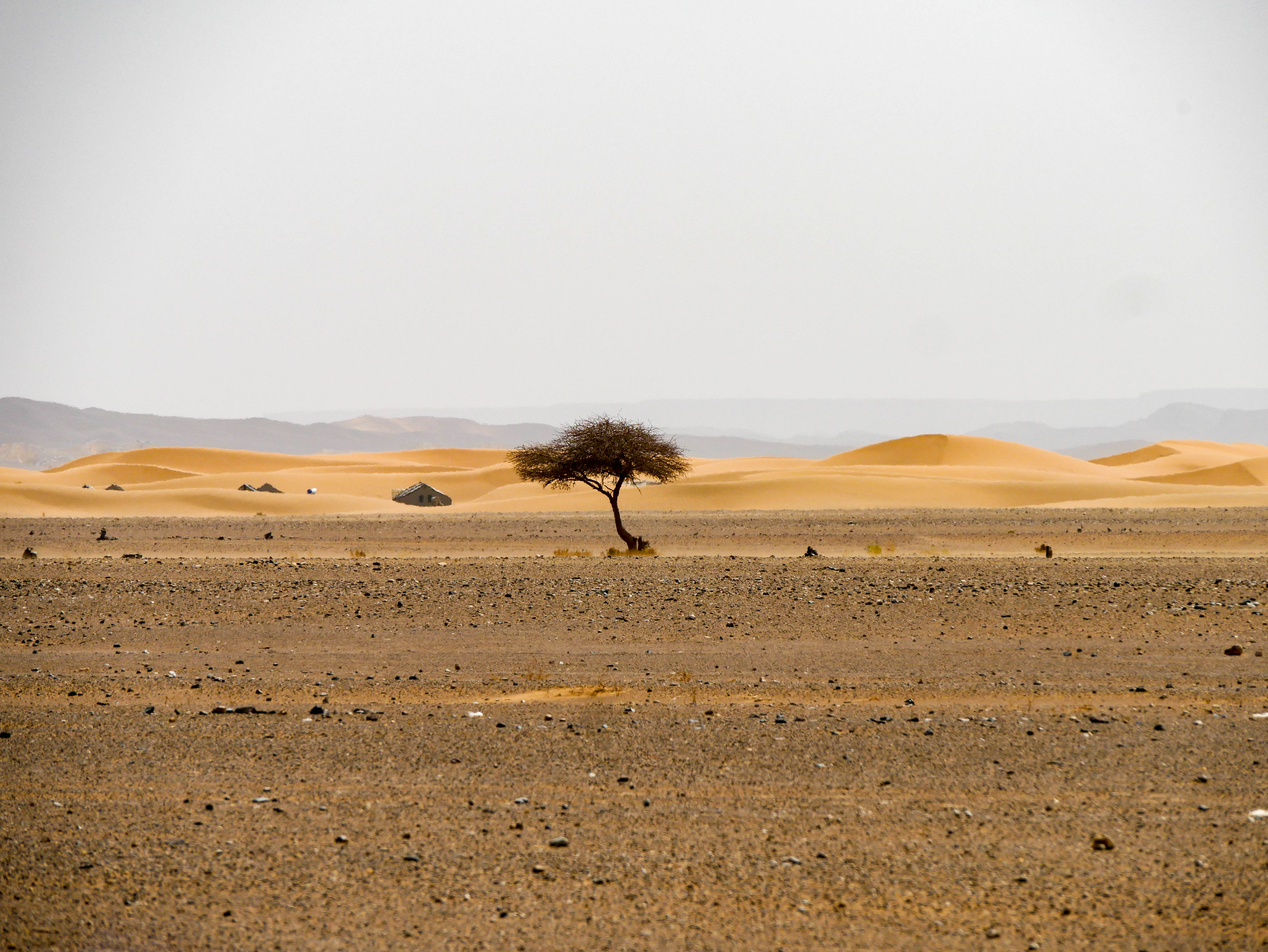
We jumped out at different viewpoints for us to take photos, braving the rising temperatures in the Sahara. Throughout the drive, Ibrahim gave explanations about scenery, the Berber people who live in Morocco (Ibrahim is one of them – along with 70% of the population of Morocco) and the nomadic people who live in the Sahara.

As we stopped to check out fossils, young kids appeared running out of the desert, stopping to unwrap a collection of souvenirs (fossil rocks, mini camel dolls made out of fabric, etc.) they hoped to entice us with.
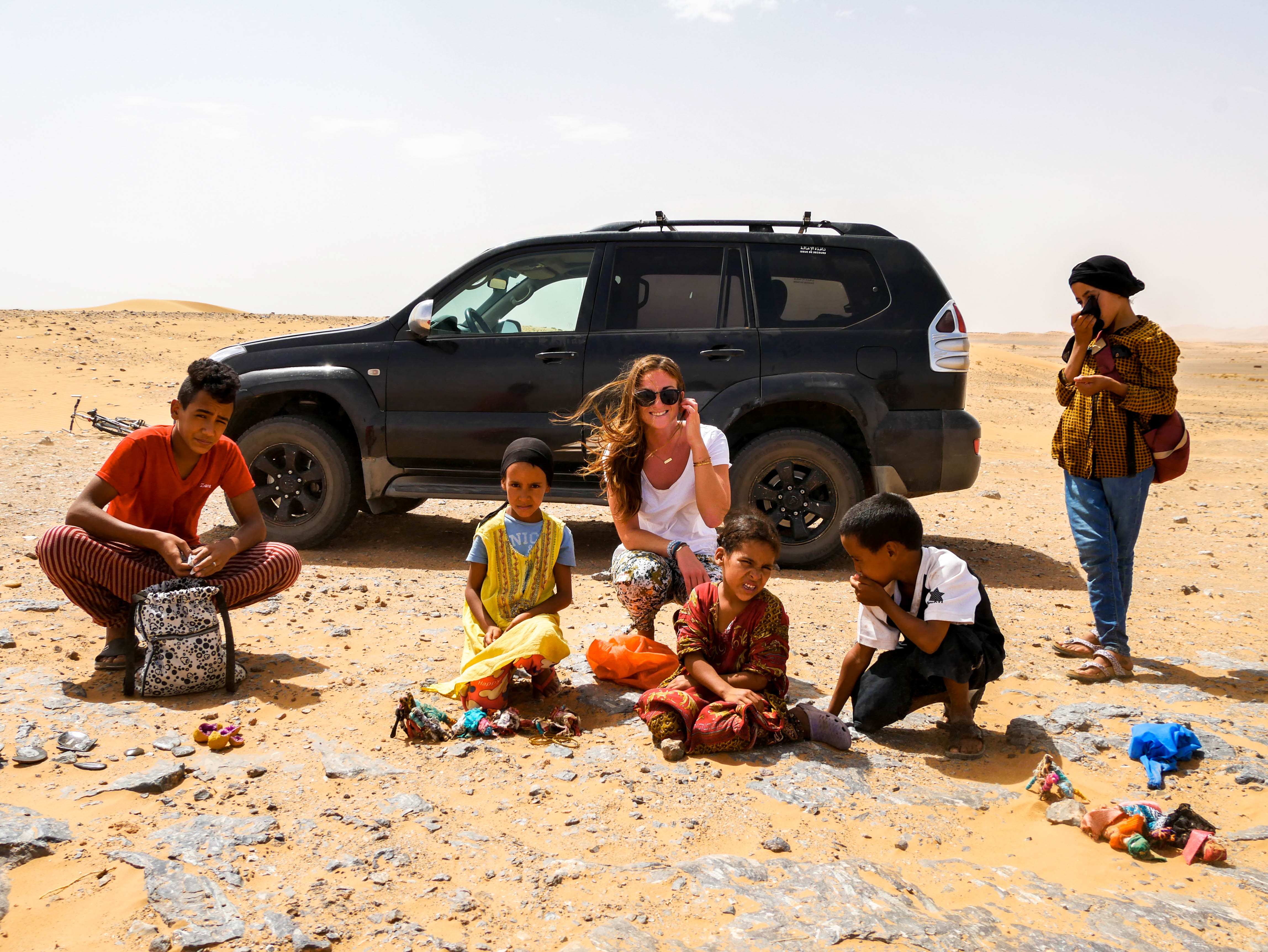
We didn’t particularly want or need any of the souvenirs they displayed, but my heart broke at their longing gazes (and we were both confused where they came from in the middle of the desert, especially in the intense heat). I got out a coin to give in exchange for a photo, and all the kids immediately stood up and starting shoving their hands towards me. Without enough coins for everyone, I looked to Ibrahim for help and he told me they would share it.
Tip: Bring lots of small coins (or maybe fruits/candies) to give to the kids in the desert. I wish we would have been more prepared or had more to give them as I felt helpless in the desert.
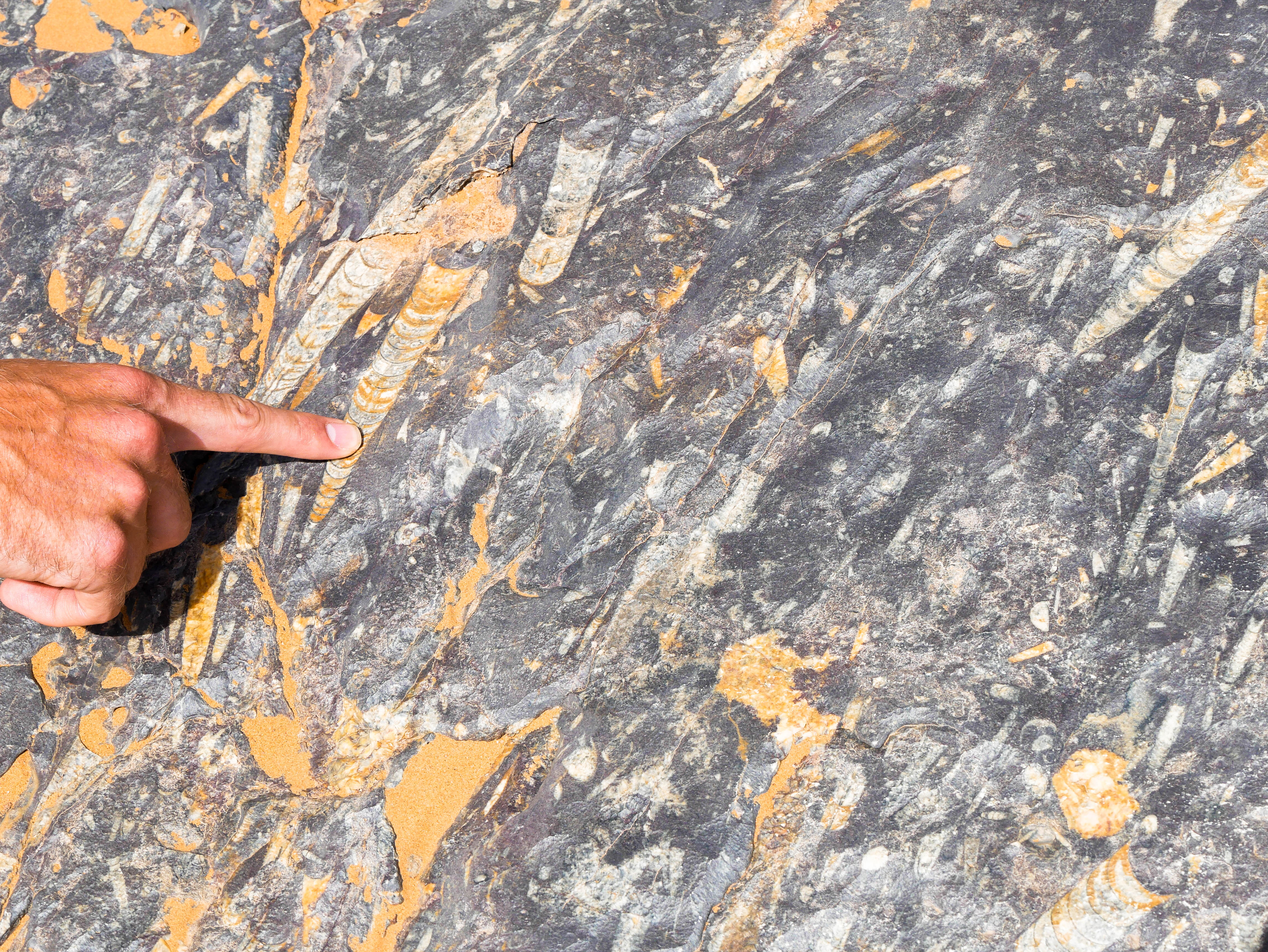
After a few more quick stops, we arrived at a nomadic set of tents/clay houses. Ibrahim had candies for the children who lived in the tents. We found out later the tents were occupied by one man (who was not around when we visited), his two wives (each with their own hut), and their six combined children. In the Berber culture, it is acceptable to have up to four wives, although the more wives you have, the more houses/tents you need to provide for them, so most men only have one or two wives.

The kids snatched up Matt’s iPhone, found the “Photos” app and immediately began scrolling through. We quickly realized they were looking for videos. They found a video of two cats fighting that Matt filmed as a snapchat in Tangier – they must have watched it 20 times. Looks like loving cat videos is universal! They also grabbed my camera and were swiping through the photos. We were surprised how they knew exactly how to use this modern technology (honestly better than some people’s parents know how to work iPhones haha).
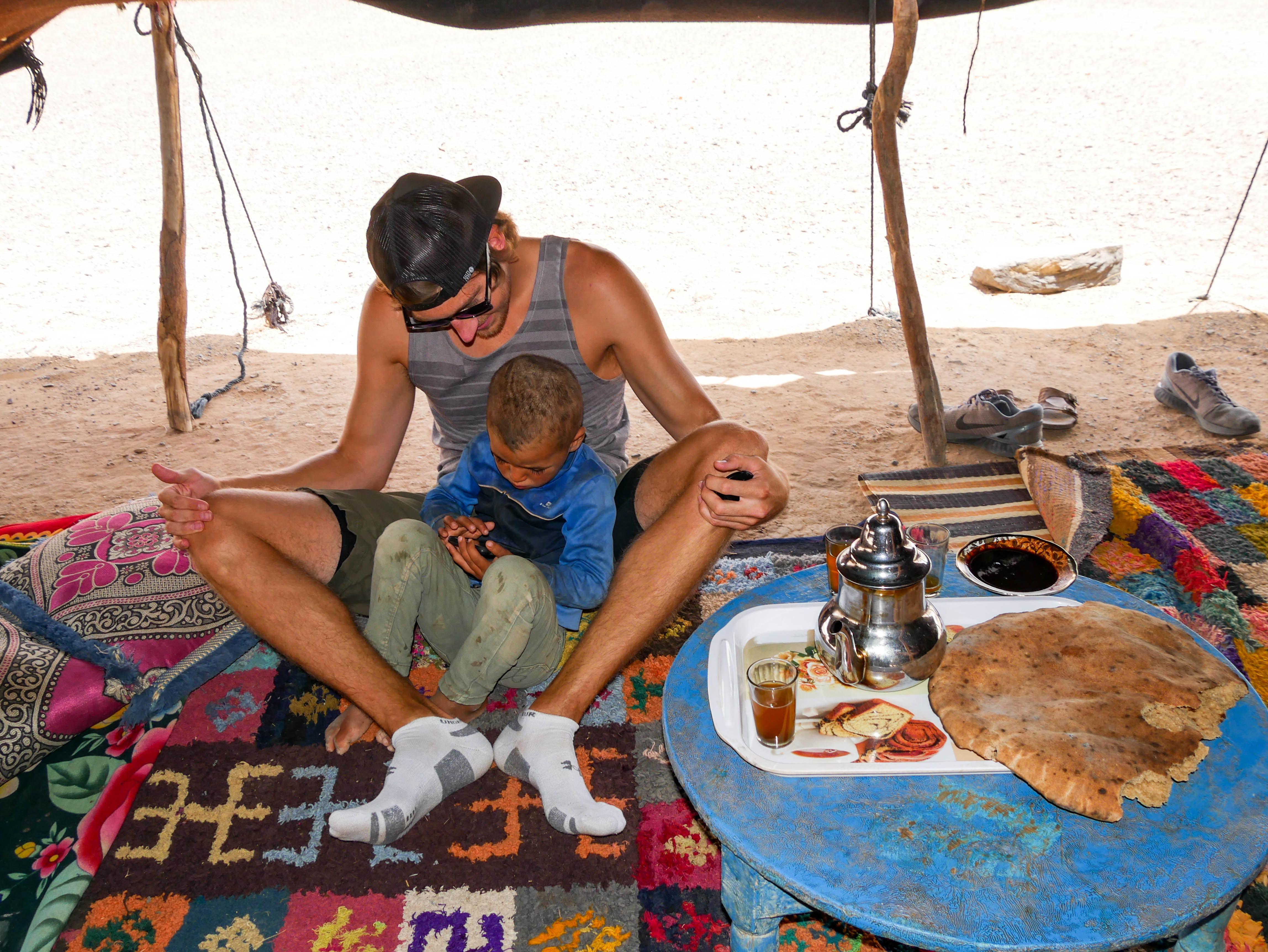
We drank more (hot) mint tea in the shade of the large tent with giant bread and date sauce. The tents and huts definitely make the desert heat more bearable.

We stepped out of the tent to the sounds of electronic music and the hottest day club in the Sahara (for kids under 10). Ibrahim had opened the door of the 4×4 as the car speaker bumped Spanish and English dance hits, the kids swiveling the hips, clapping, and jumping to the rhythm. They were adorable – I tried to join in but they didn’t seem to care for my moves.

We stopped in Rissani for traditional Berber Rissani pizza, which wasn’t anything like the pizza we are accustomed to. The pizza was more like a thick pita bread stuffed with meat and vegetables in a seasoning/sauce that was similar to curry. It was tasty!
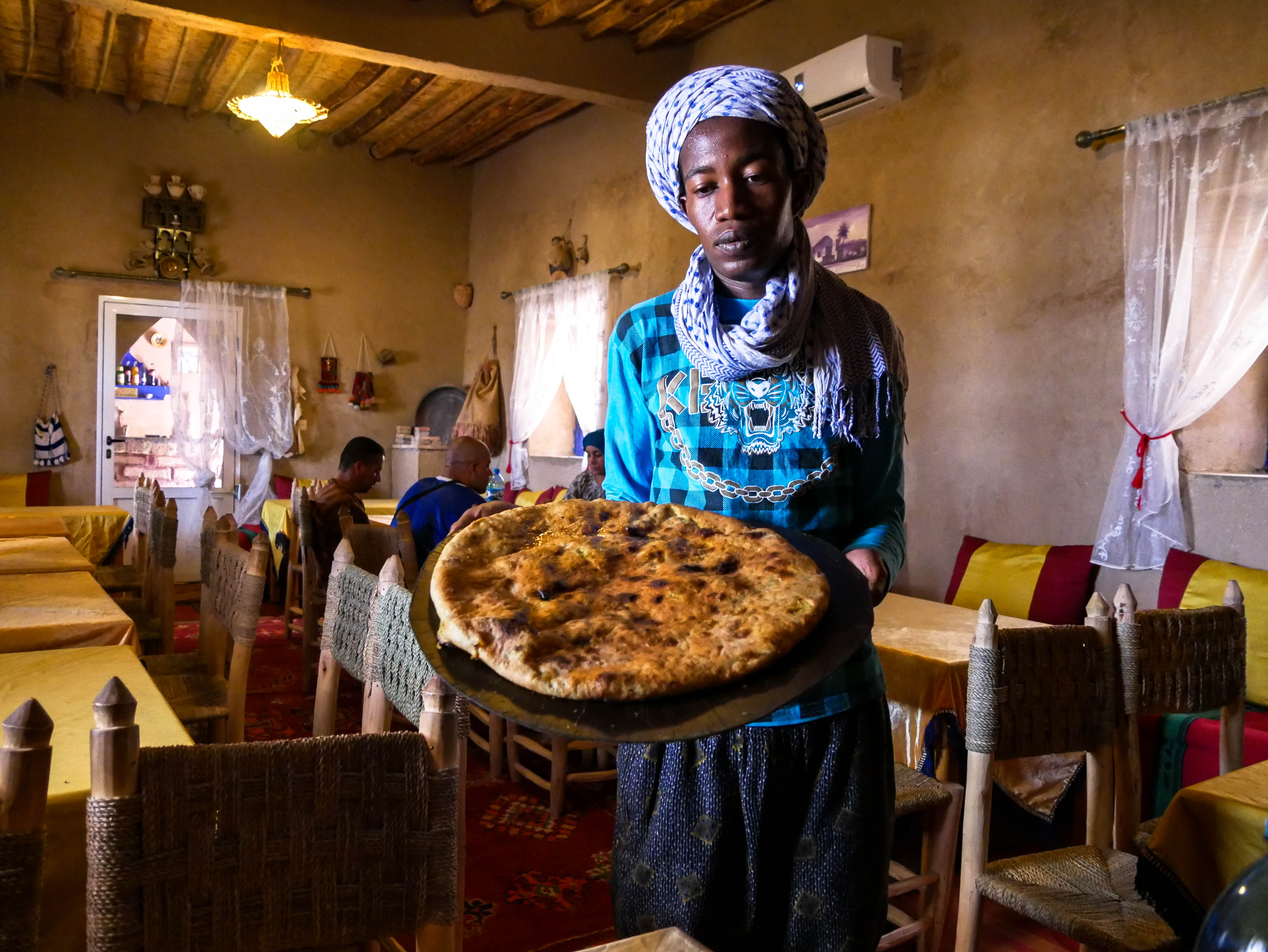
We stopped at a new riad, where we were again greeted with mint tea. We relaxed and swam in the pool, and repacked our small backpacks for the trek.

As we swam, clouds emerged, blocking our view of the dunes in front of us. We grew anxious about the weather in the desert and disheartened that we wouldn’t be viewing a desert sunset.
Just before 7 p.m. we were collected from the riad, given turbans for our ride to protect us from the desert sun and sand, and mounted our camels. Getting on the camel is one of the most fun/exhilarating parts of the camel ride (as is getting off). You mount the camel while it is laying on the ground, and it will jerkily get to its knees and finally to its feet.

The views through the desert were stunning. I couldn’t help but sing “Arabian Nights” from Aladdin in my head. The actual camel ride isn’t the most comfortable or smooth experience – the hour and a half ride was definitely enough time on the camels.

Sadly, the clouds obscured any chance we had at viewing a desert sunset. When we reached the camp, we chatted with the other couple on our camel trek as we drank (can you guess?) mint tea and waited for dinner. They happened to be Canadians from Vancouver B.C. (which is only a few hours away from Seattle! Small world).
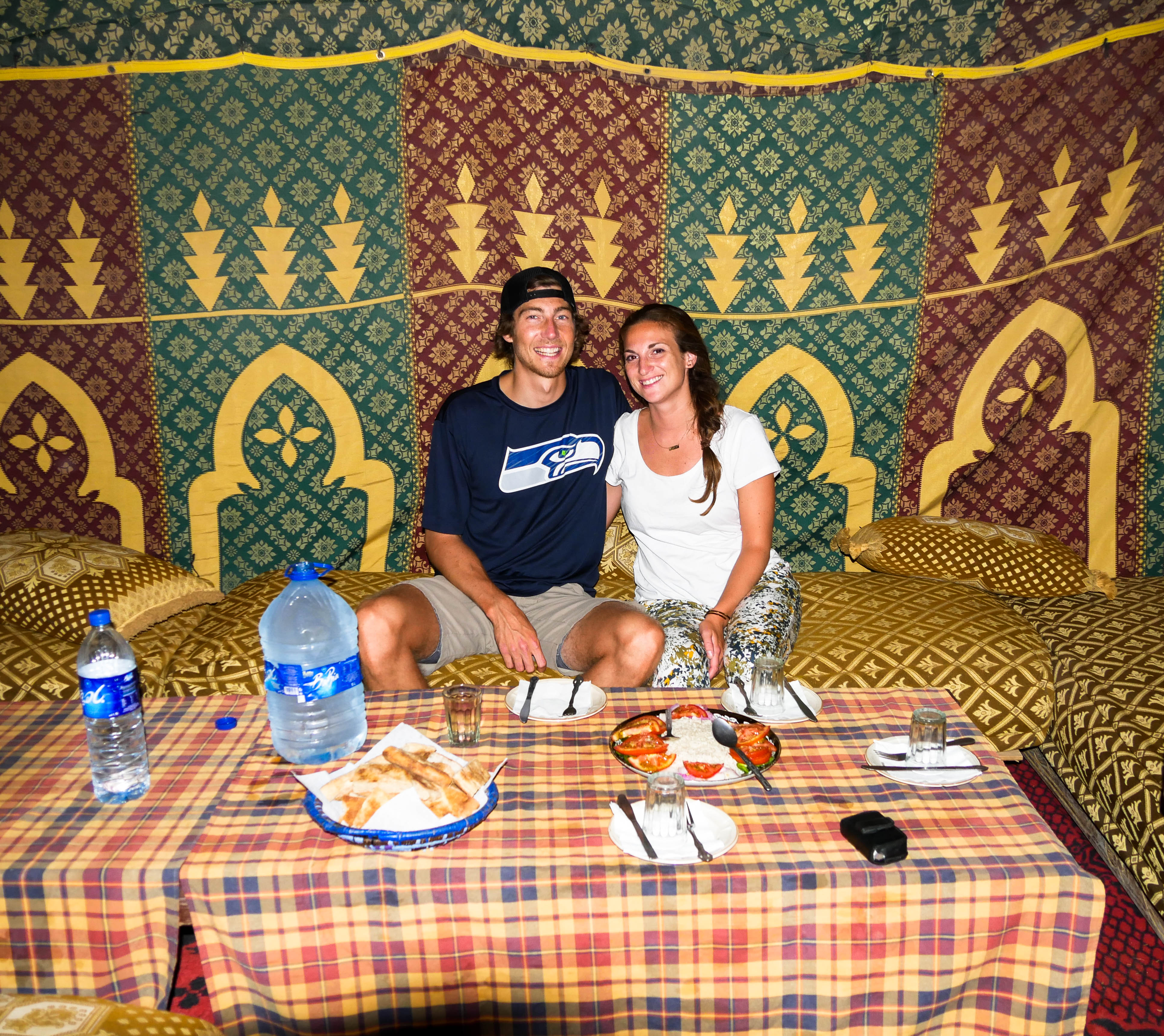
After dinner, the sounds of Berber drums drew us out of the tent. I joined in on playing the drums. Our camel guide Mohammed asked us to play an American or Canadian song, and then mentioned the song “Waka Waka (This is Africa)” by Shakira. I coincidentally have that song my iPhone since it was one of my cardio songs for the Yoga Sculpt classes I used to teach back home. I played it on my phone while we drummed and sang along.
We chatted with our guide Mohammed well into the night. Mohammed speaks seven languages and has been guiding for seven years. His favorite phrase – shouting “Africa!” which we’re sure tourists find amusing.
We all took turns asking him questions about his life in the desert, camels, Berber people, tourists, etc. The night evolved into an unannounced game of “hot seat” or “21 questions” (times at least five), abundant with laughter.
“Do the camels ever fall down when people are riding them?” We all questioned.
“Yes,” Mohammed answered so matter-of-factly and simply that we burst out in laughter. Little did we know we’d experience that the next morning.
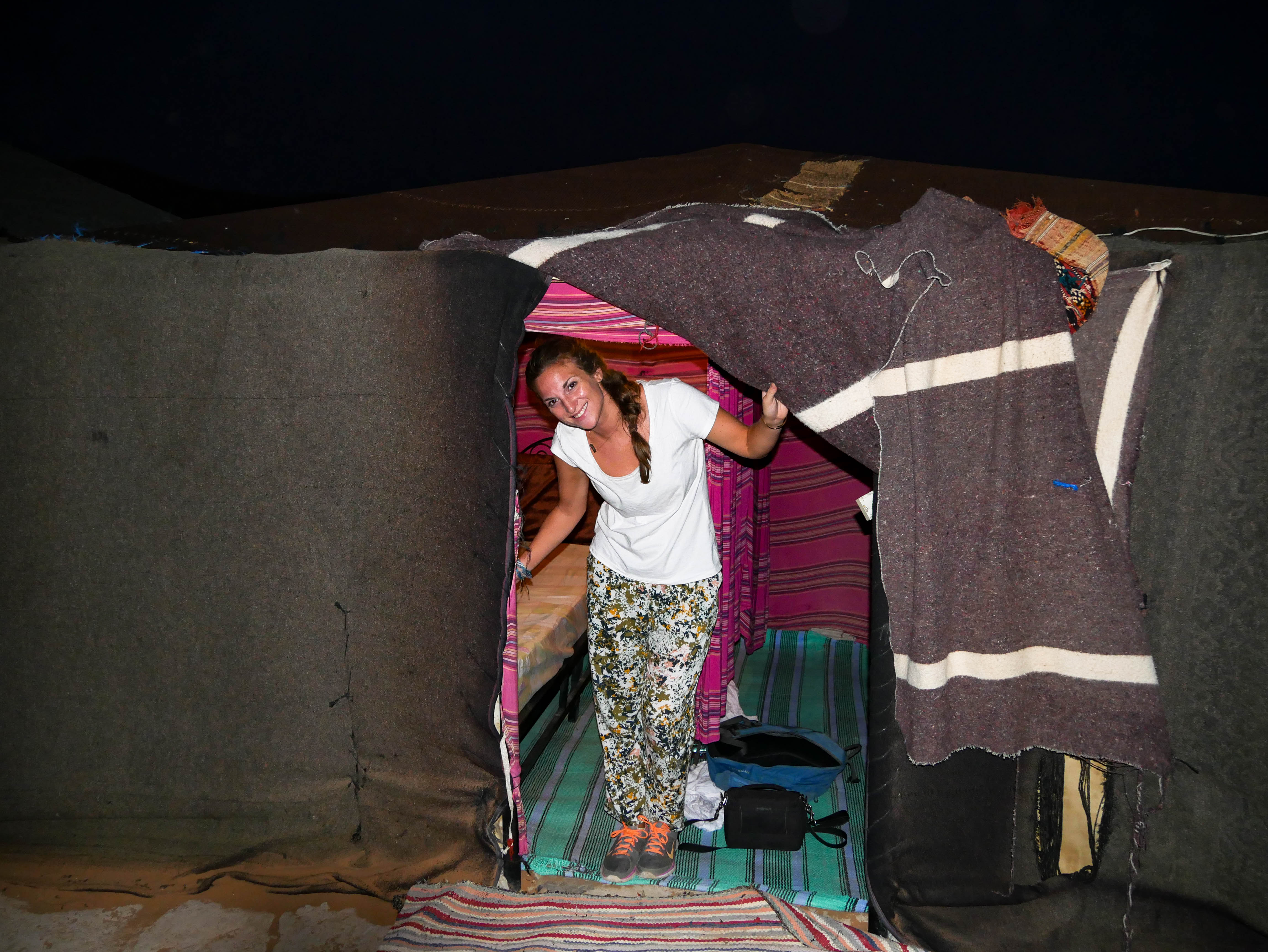
The stars eventually made an appearance and we spent time stargazing, witnessing shooting stars. Mohammed had a star gazing app on his smart phone and we were able to identify the constellations of Virgo and Leo. We stayed up well into the early morning (past 1 a.m.), before retreating to our tents.
Day 3: Sunrise in the Sahara, traveling to the Todra Gorge and night in the Dades
We woke up before 6 a.m. to catch the sunrise. It was already getting light out and pretty hazy, so we were a little worried that we had missed our chance at the sunrise too. But by the time we climbed back up to the dunes behind the campsite, just before 6:30 a.m., we were able to see the sun rising behind the haze.
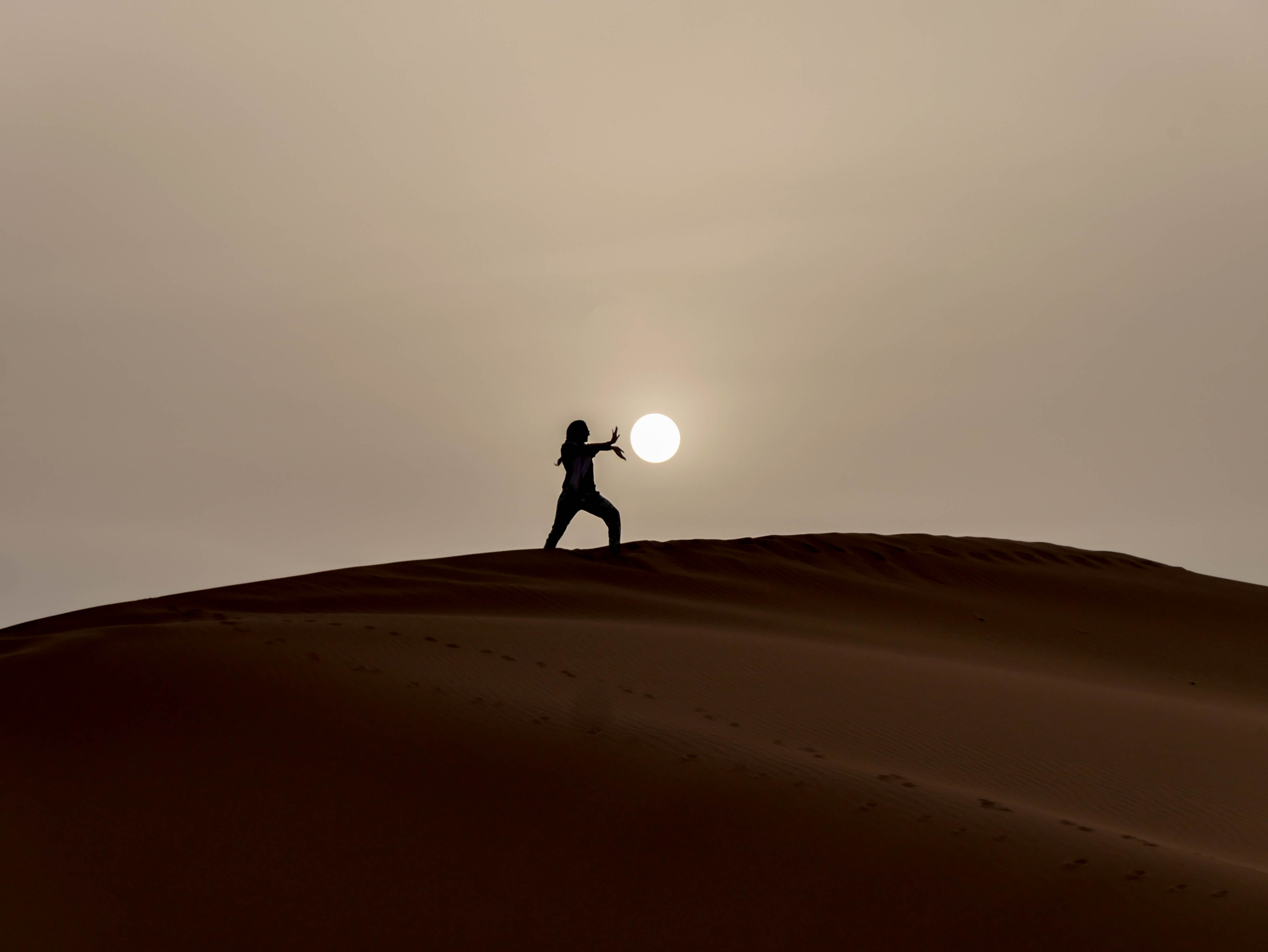
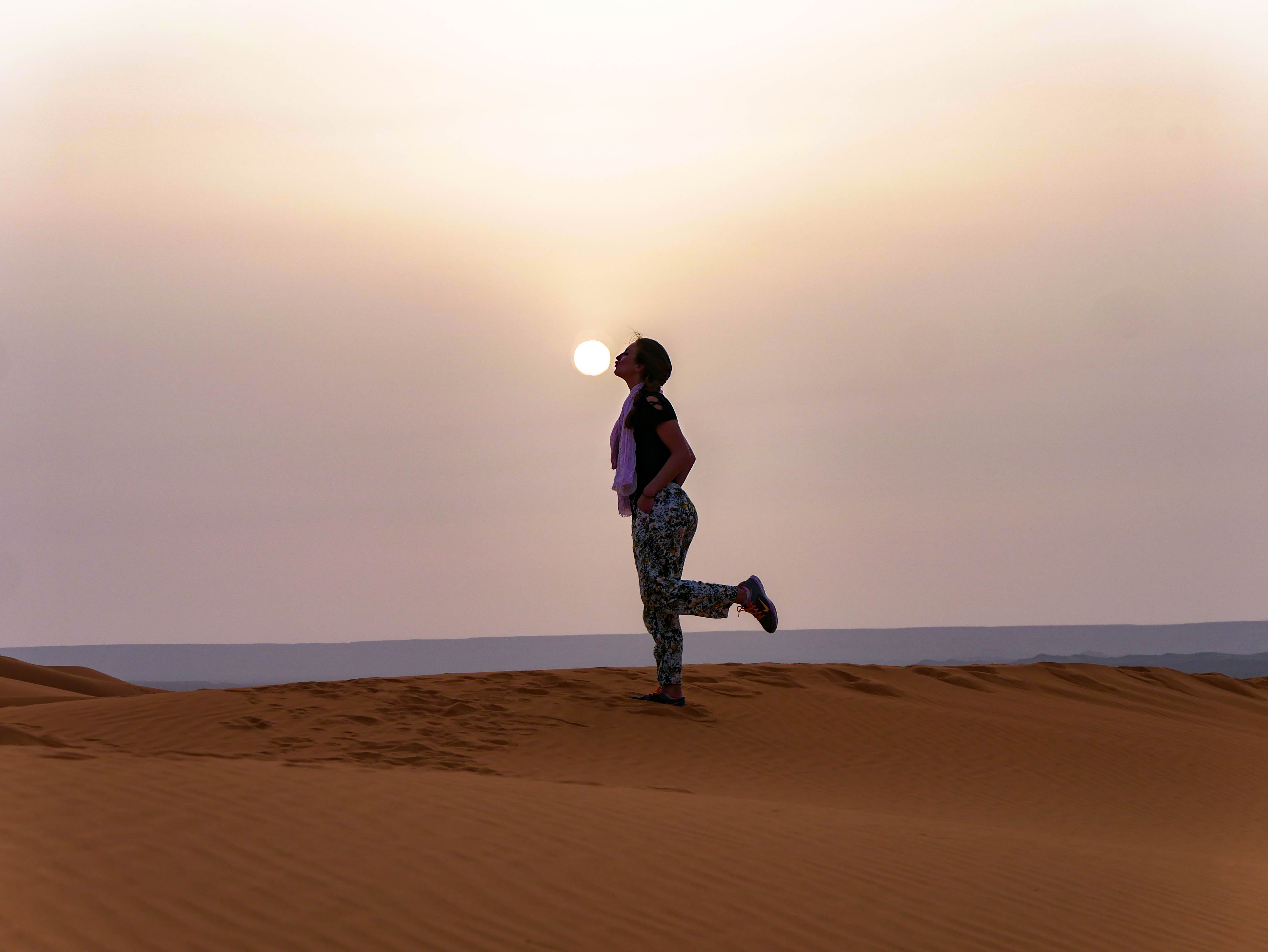
Then we headed back on our camels to Merzouga. As I rode the larger lead camel on the way to our desert camp and Matt road the smaller camel behind me, we decided to trade camels on the way back since he thought the larger camel might make his morning ride more comfortable.
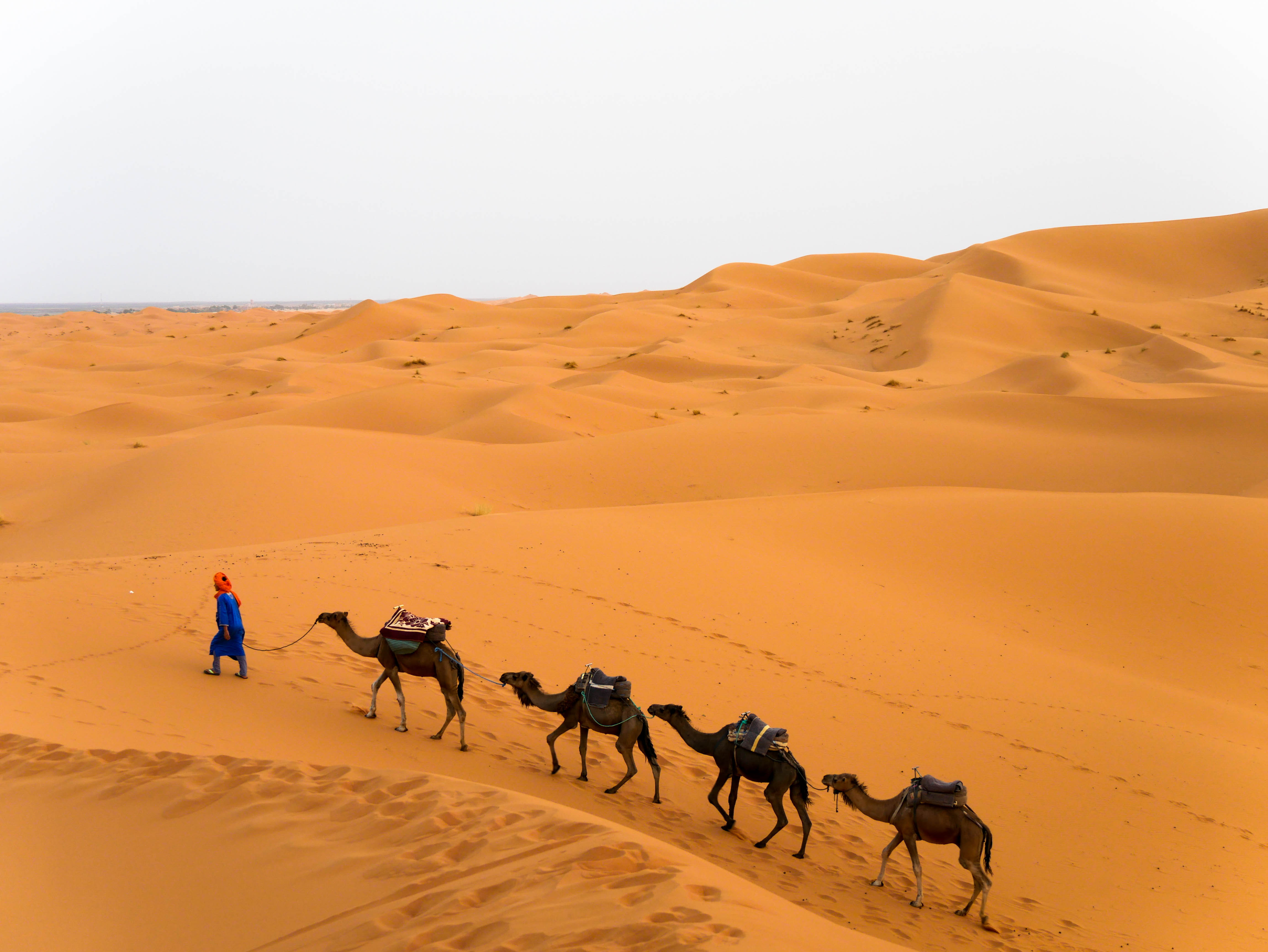
Unfortunately, Matt’s camel took a tumble and collapsed to its knees, causing Matt to fall off and land in a hard area of sand. Matt was a little dazed with the wind knocked out of him, but thankfully not seriously injured. The camel appeared to be okay as well. In truth, it looked pretty funny as an observer, but I refrained from laughing out of respect for Matt. We both wish that we had it on video (talk about a viral video!).
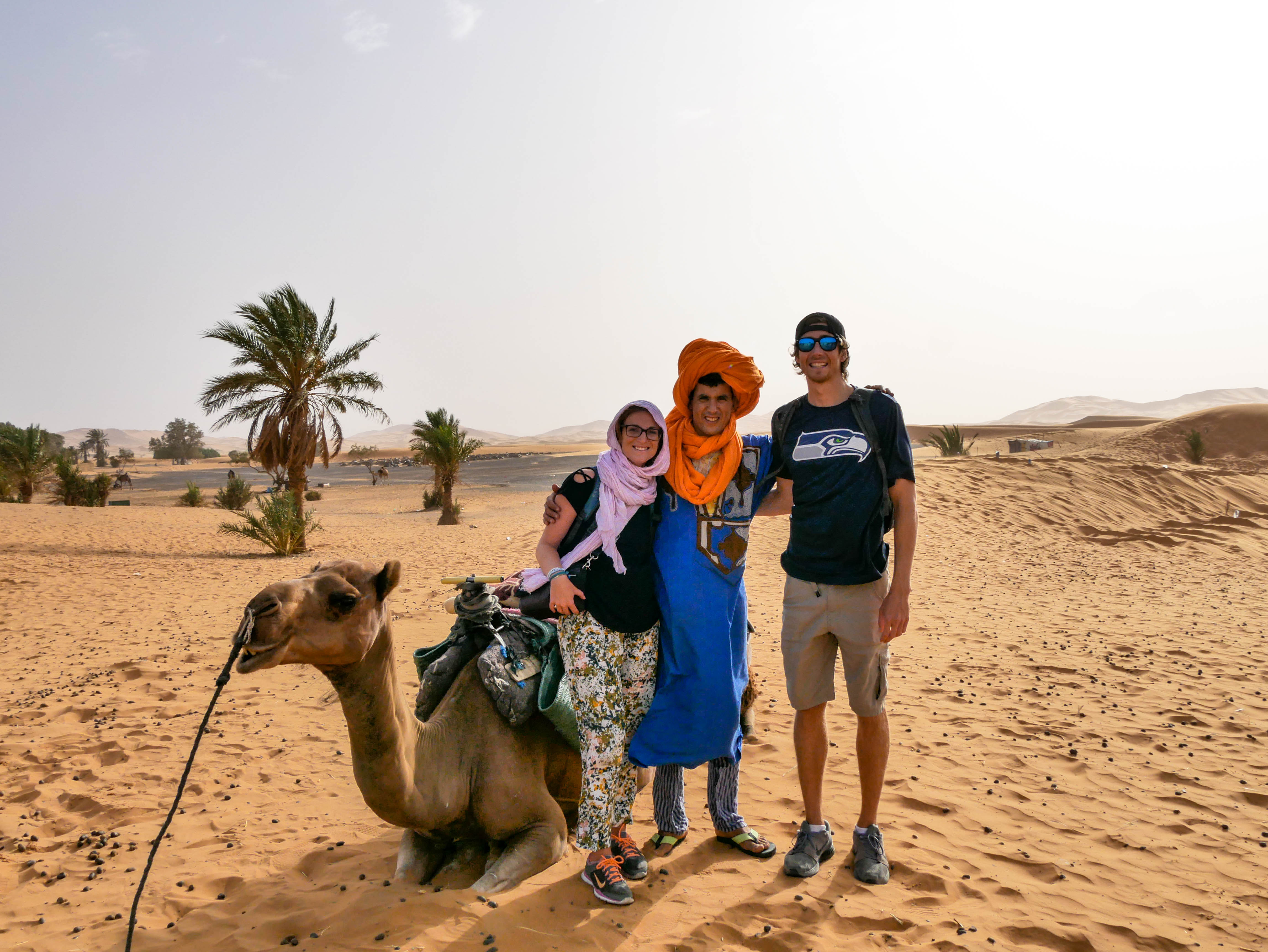
After breakfast at the riad, a quick jump in the pool, and showers, we rejoined Ibrahim and headed out of the Sahara.
Our first stop of the day was at an old water system of dried up wells.

We descended underground to visit the system from below, which was dark and cool (much to our pleasure). A guide turned on lanterns to illuminate the path in between wells that filtered sunlight from above.
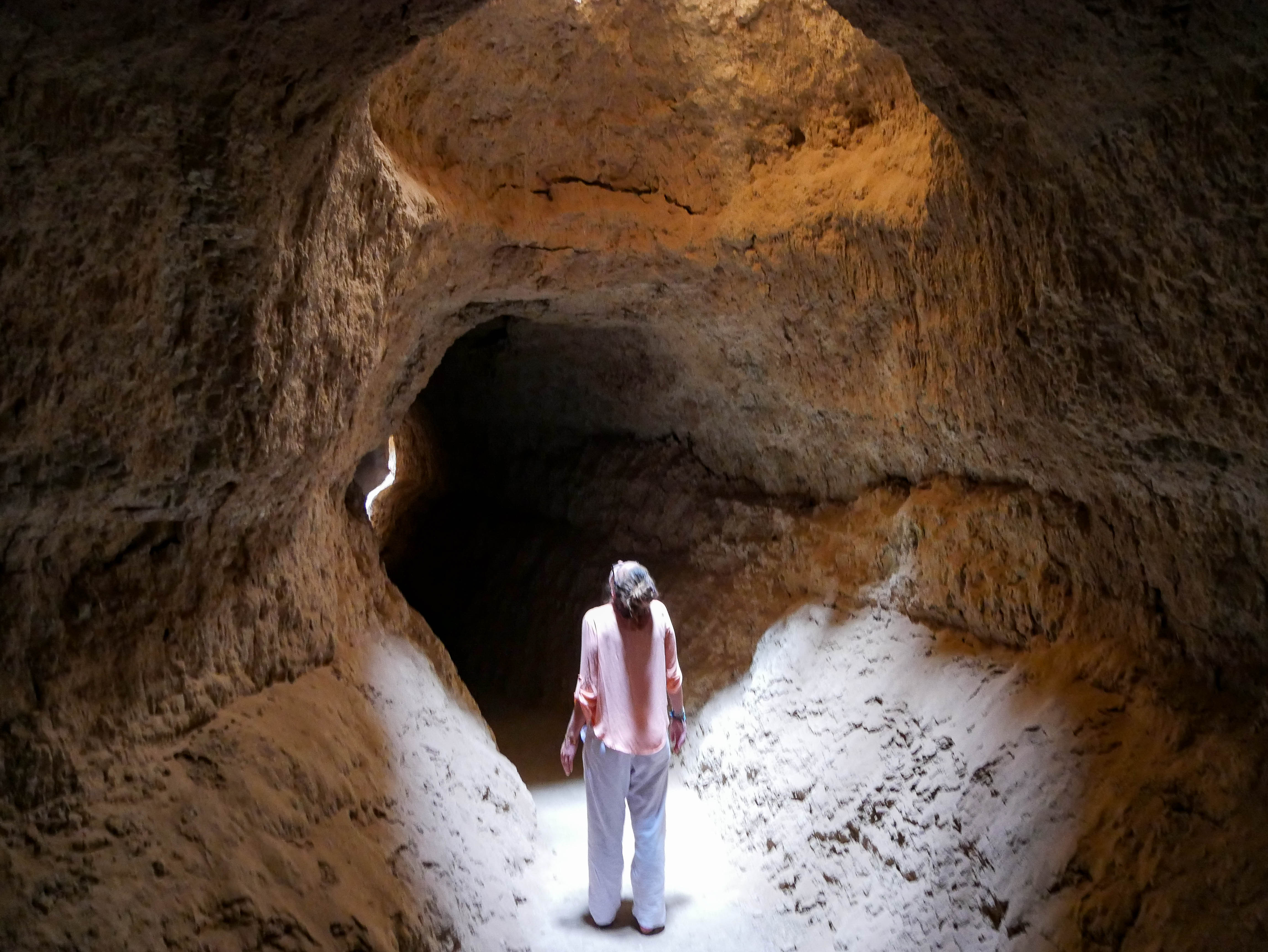
We hit the road again, heading to Tordra gorge.

We stopped at several viewpoints to take photos of the stunning scenery.
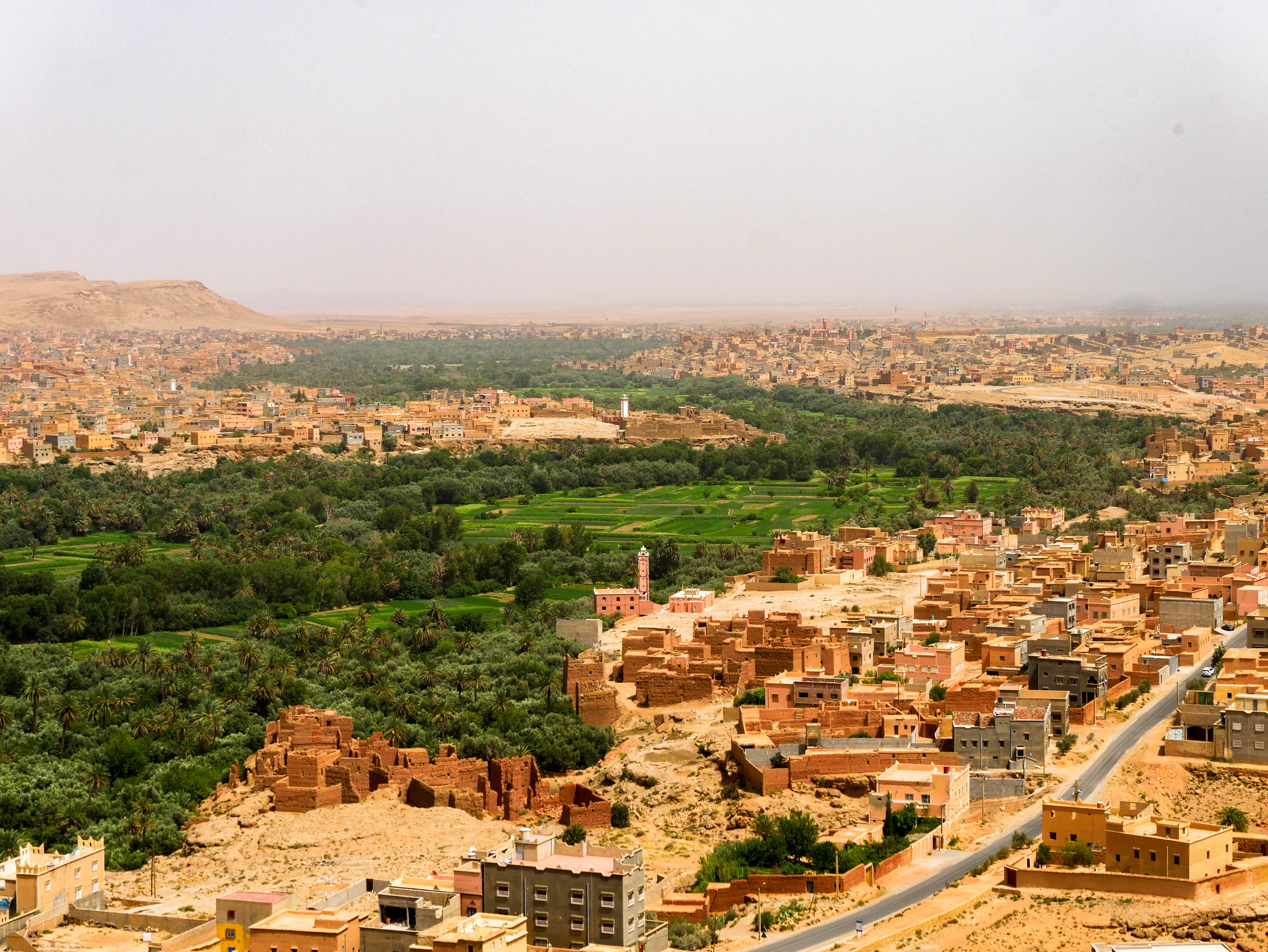 We arrived at Todra Gorge, which was breathtaking. Tucked between high mountains, a small river cuts through the orange rocks. The gorge was packed with locals enjoying the cool water and the shade of the gorge.
We arrived at Todra Gorge, which was breathtaking. Tucked between high mountains, a small river cuts through the orange rocks. The gorge was packed with locals enjoying the cool water and the shade of the gorge.

The water source is actually fueled from an underground spring but was the running water was minimal this time of year (in summer).
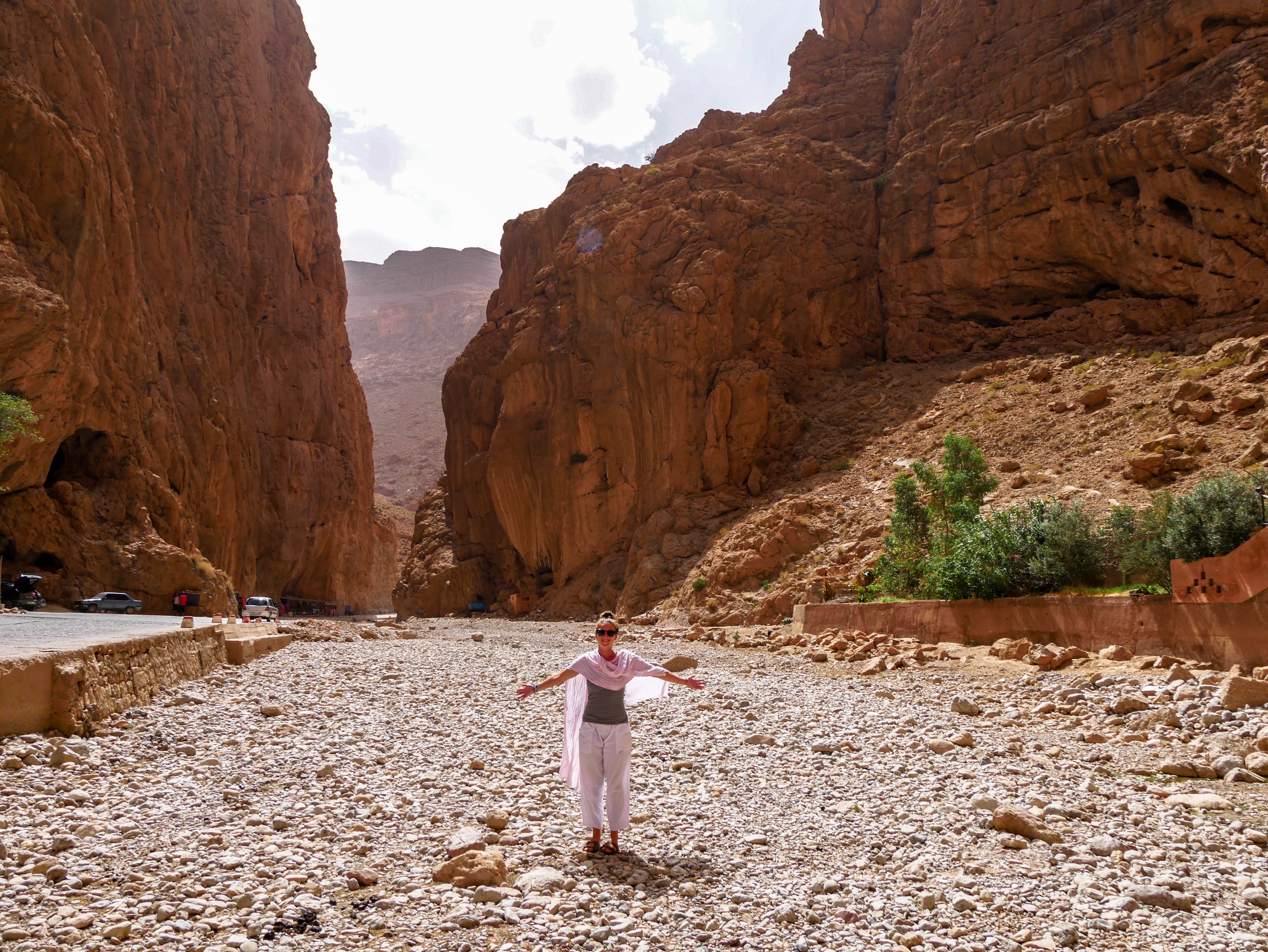
Todra Gorge is also known for rock climbing.
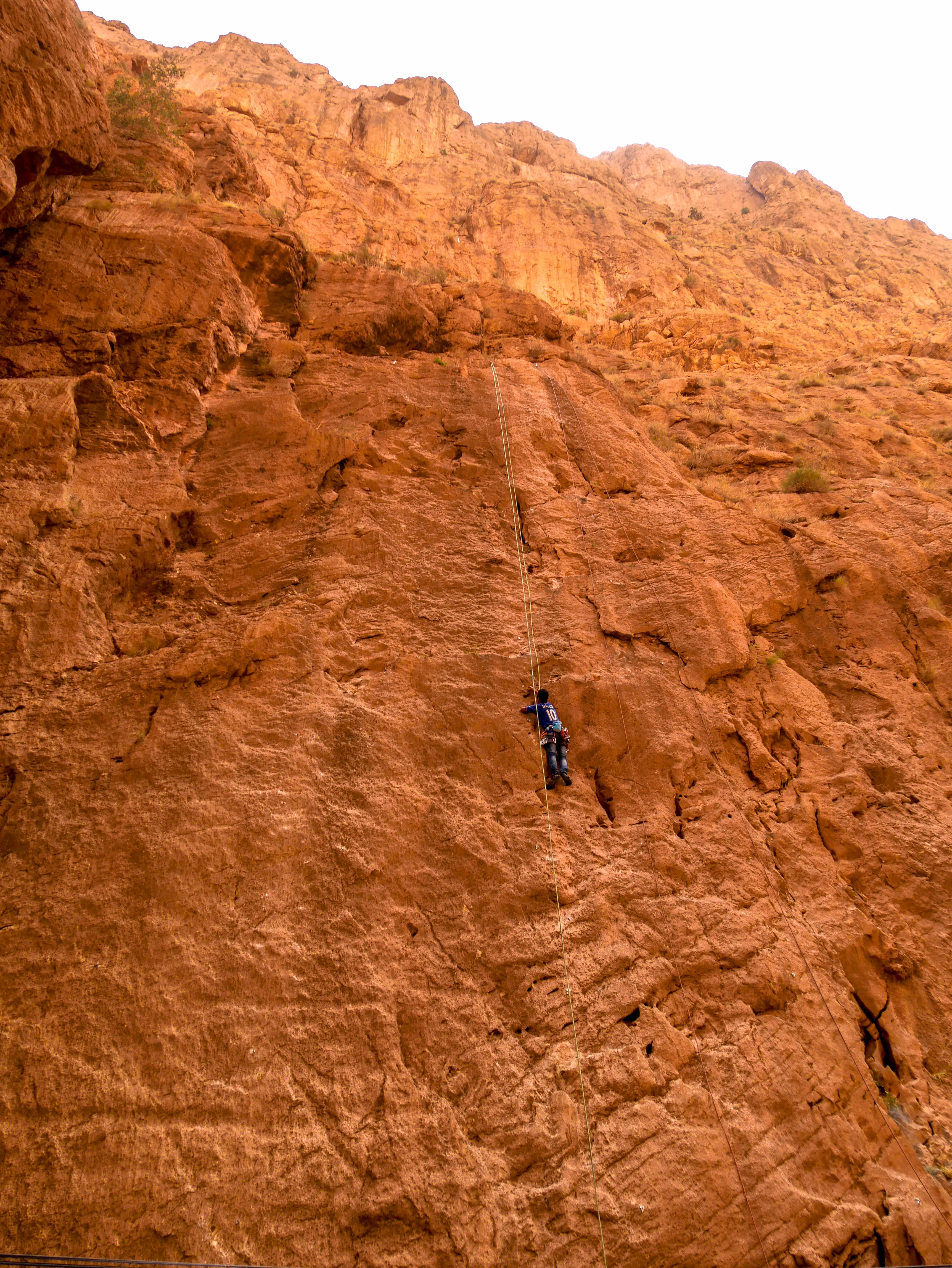
After lunch at a roadside restaurant packed with tourists, we continued on to Dades gorge. With gorgeous red and orange rocks and lush green trees, the sheer contrast of the scenery was stunning. It reminded me of Christmas (red and green).
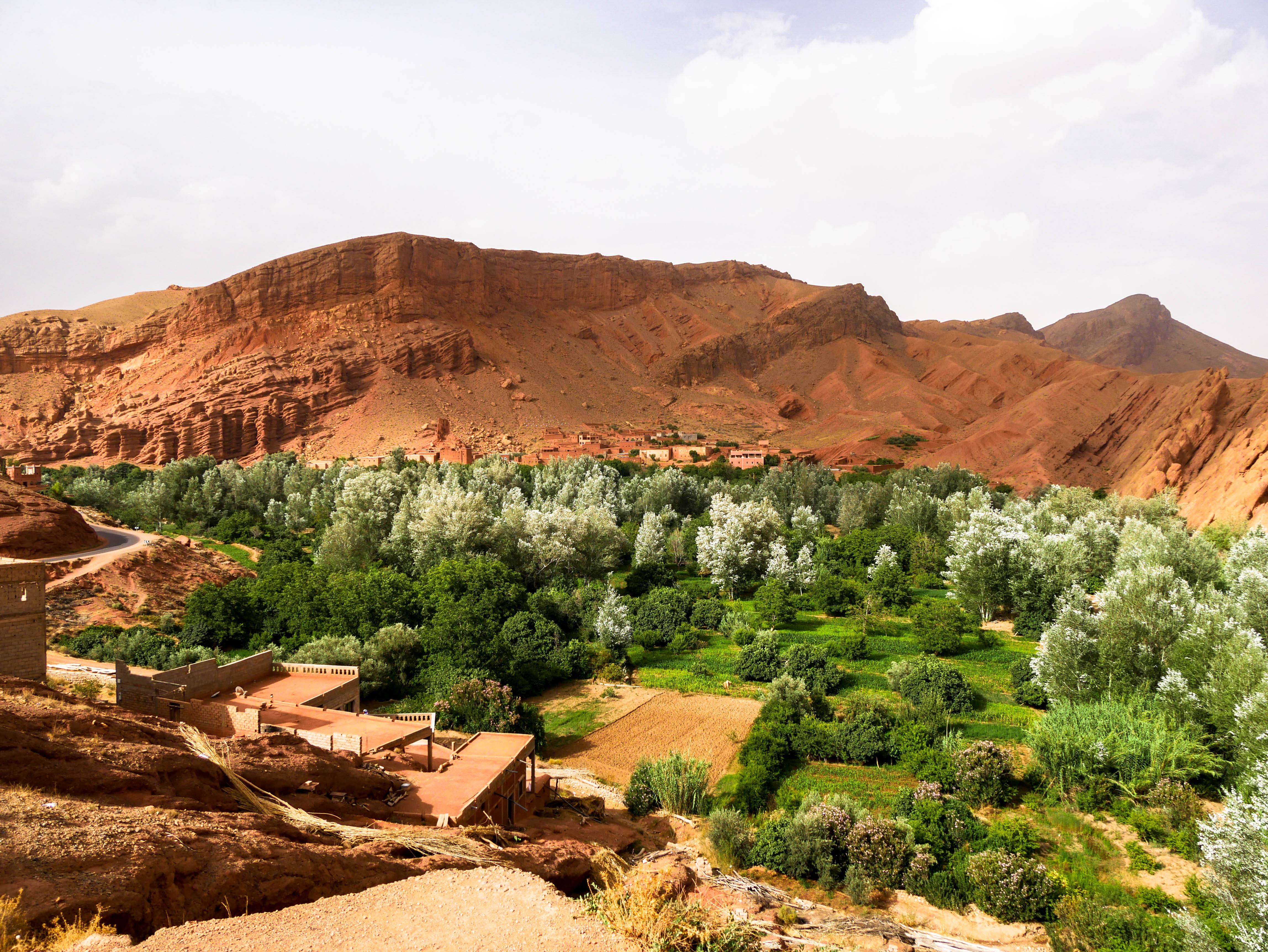
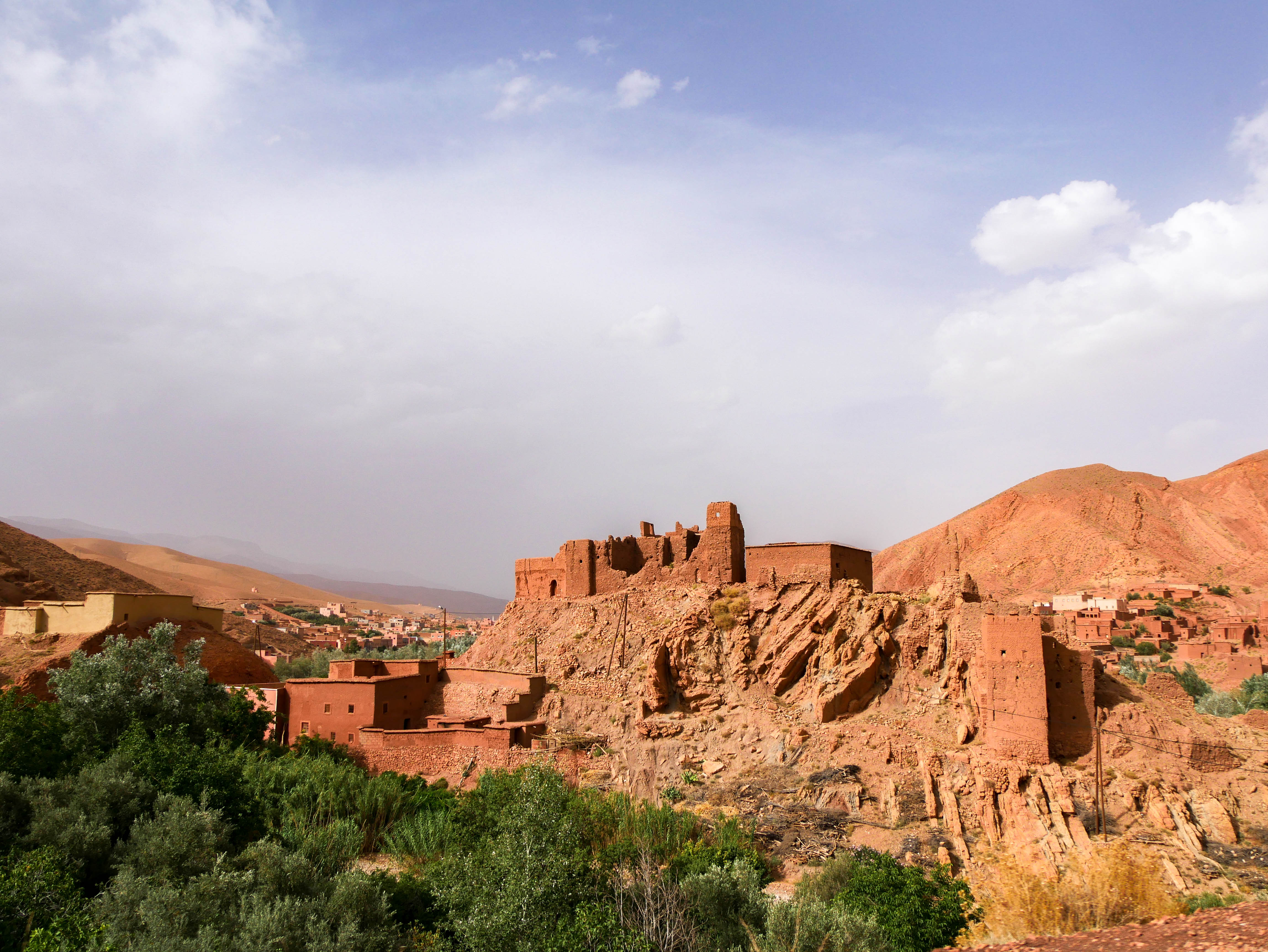
We drove to the top of Dades Gorge to enjoy the view from the top.
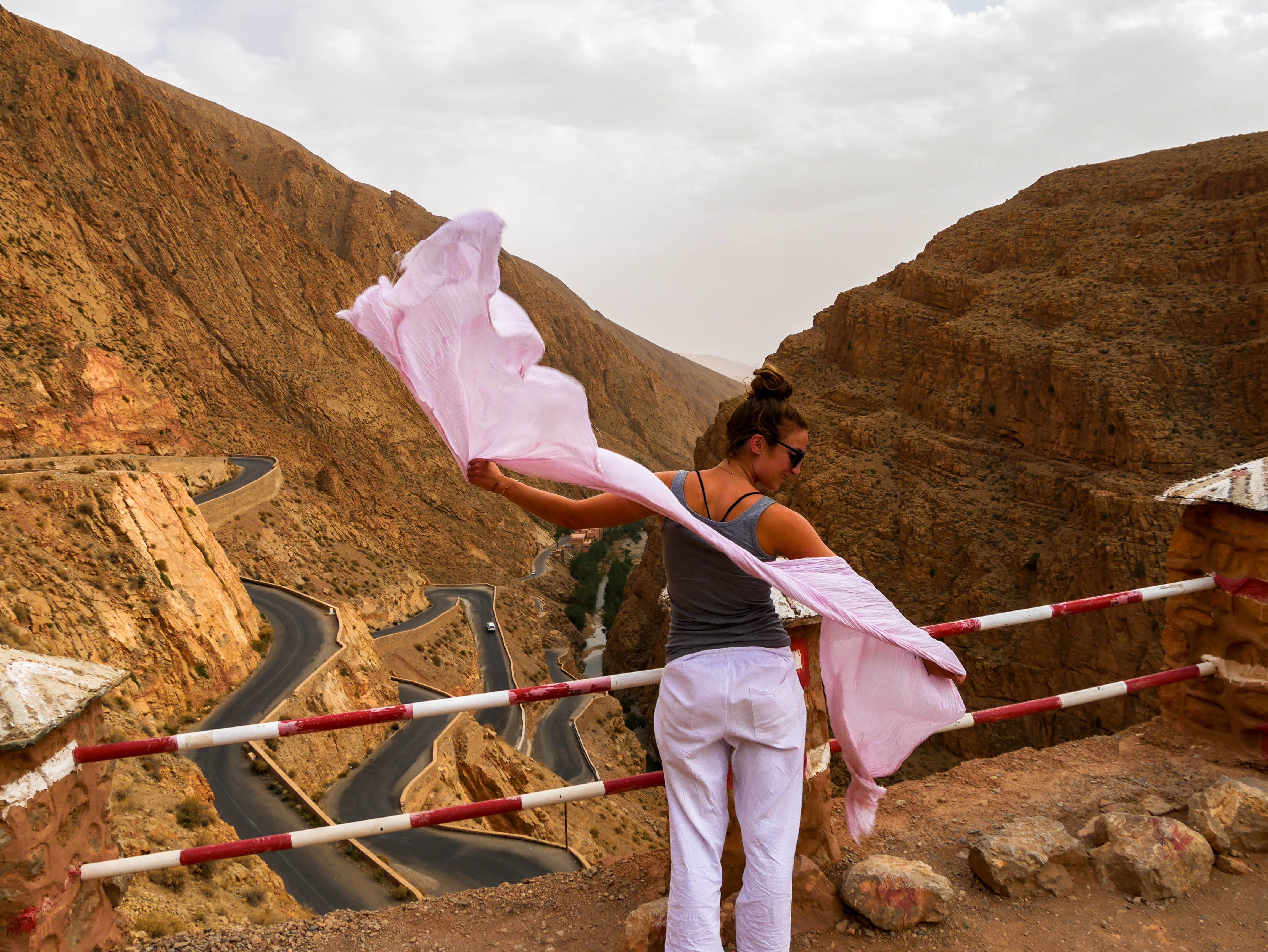
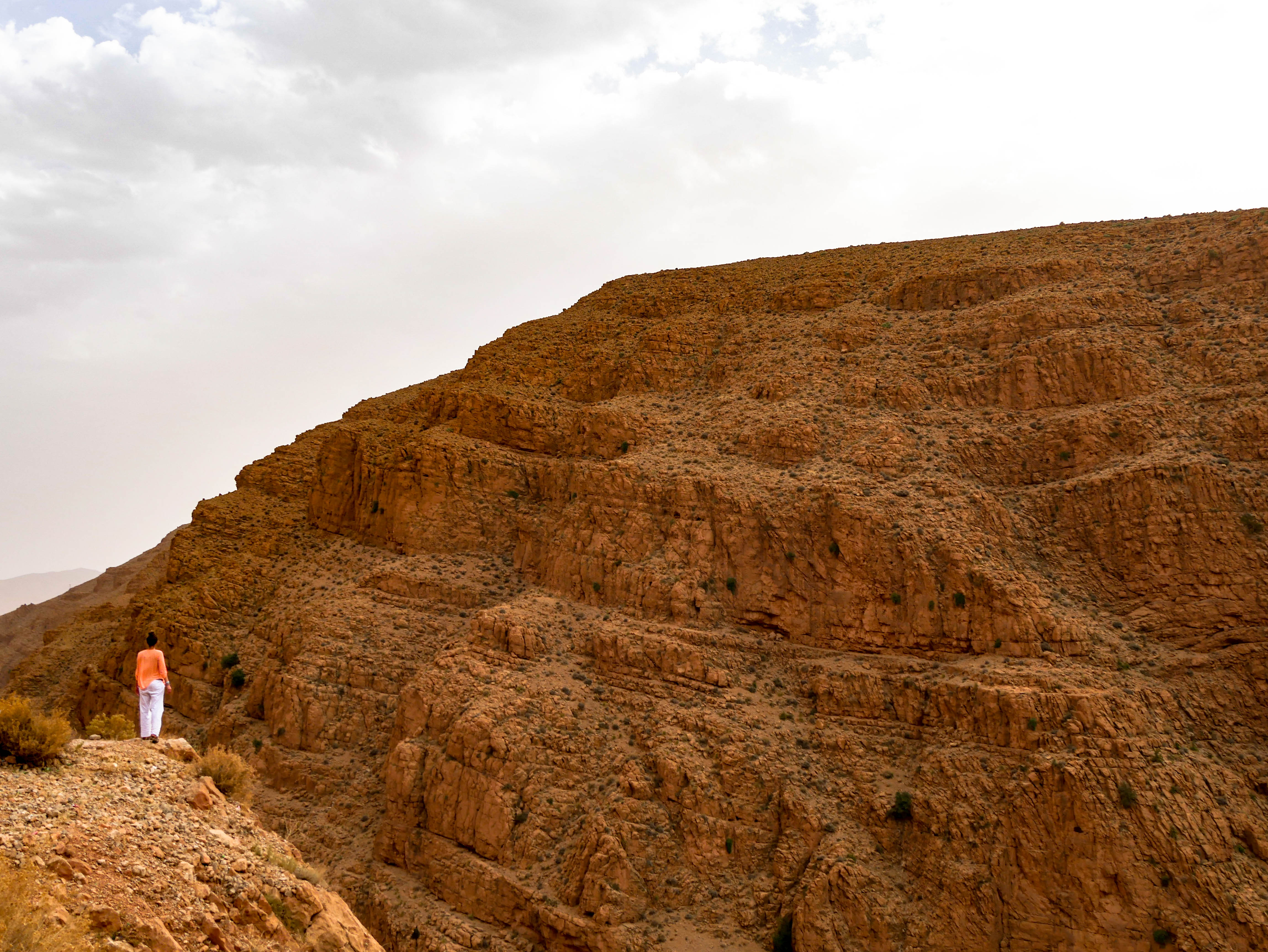
We ascended back down only a few minutes to our hotel – Hotel Babylon Dades. Of course, we had mint tea on the terrace and enjoyed the cooler temperatures inside the gorge (90’s instead of 100+ degrees).
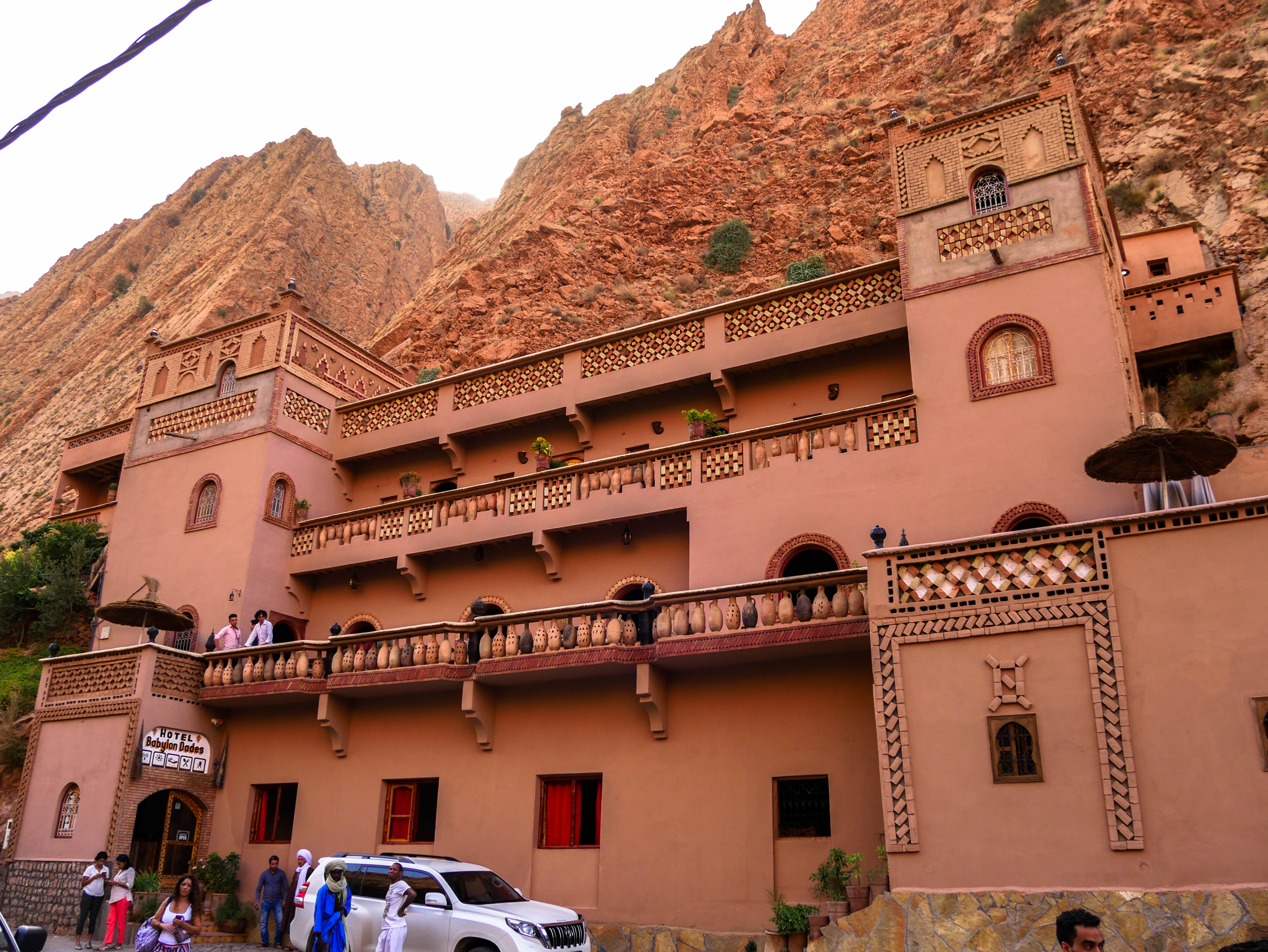
We enjoyed a Moroccan dinner at the hotel and another spacious room – this time with a balcony and view of the Dades.
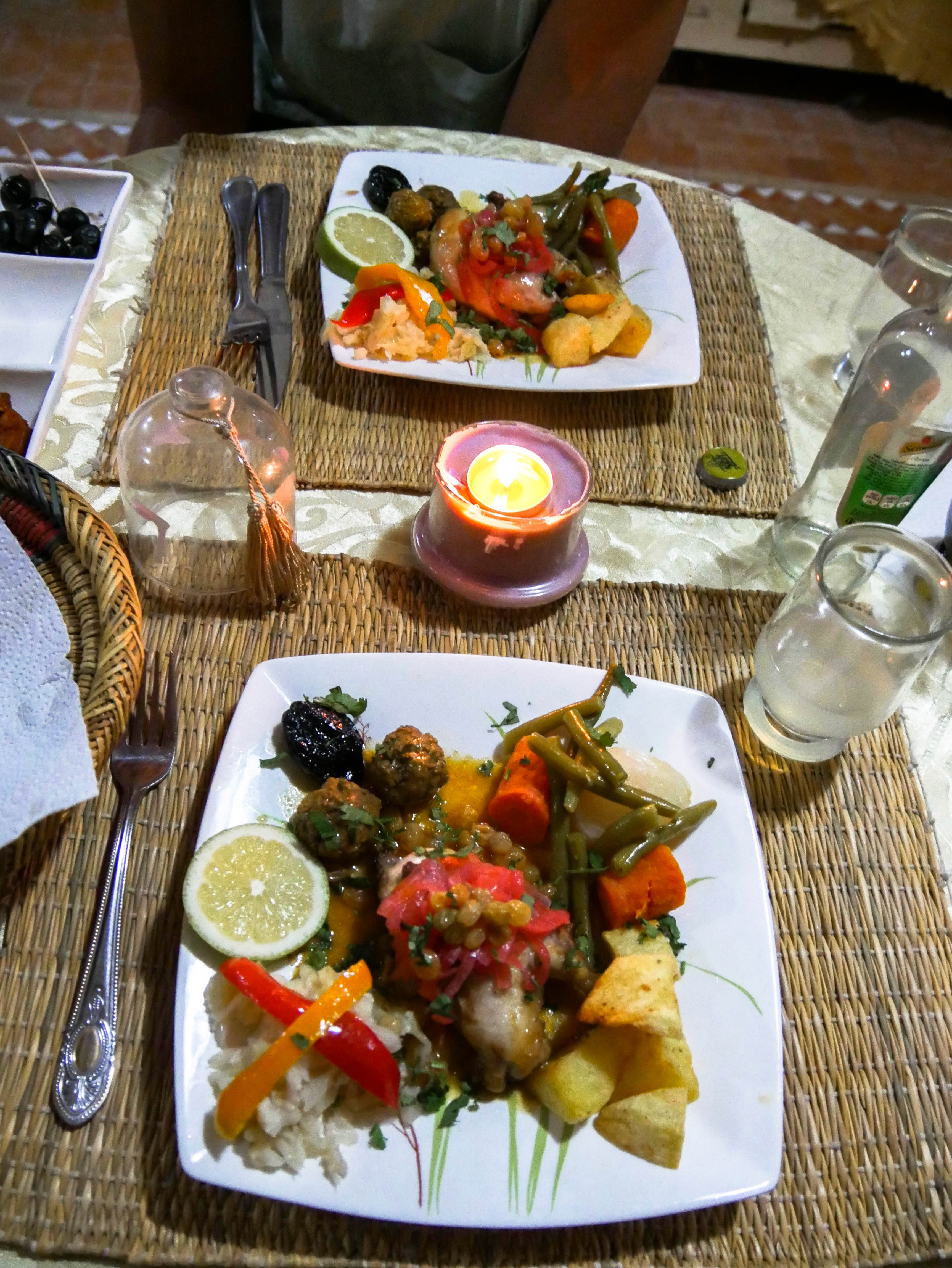
Day 4: Drive through Rose Valley and Morocco’s Hollywood, visit famous UNESCO heritage site, highest road in Morocco
On our final day of the trek, we had the best breakfast buffet at our hotel with crepes, fresh fruit, hard boiled eggs, pastries and more.
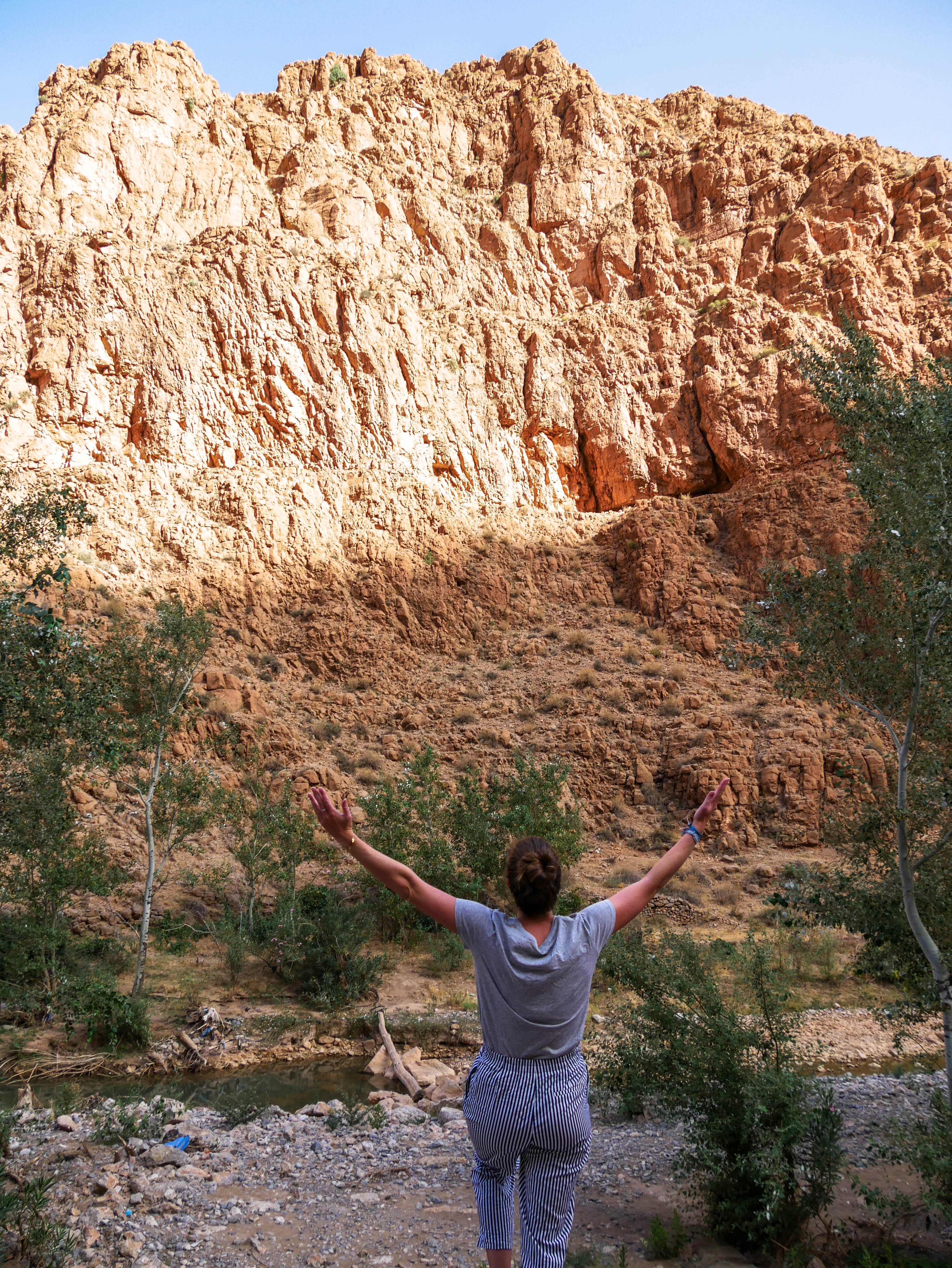
We drove through Rose Valley, although the roses were not in season (they bloom in May). We stopped to check out the different rose products, from oils to lotions.
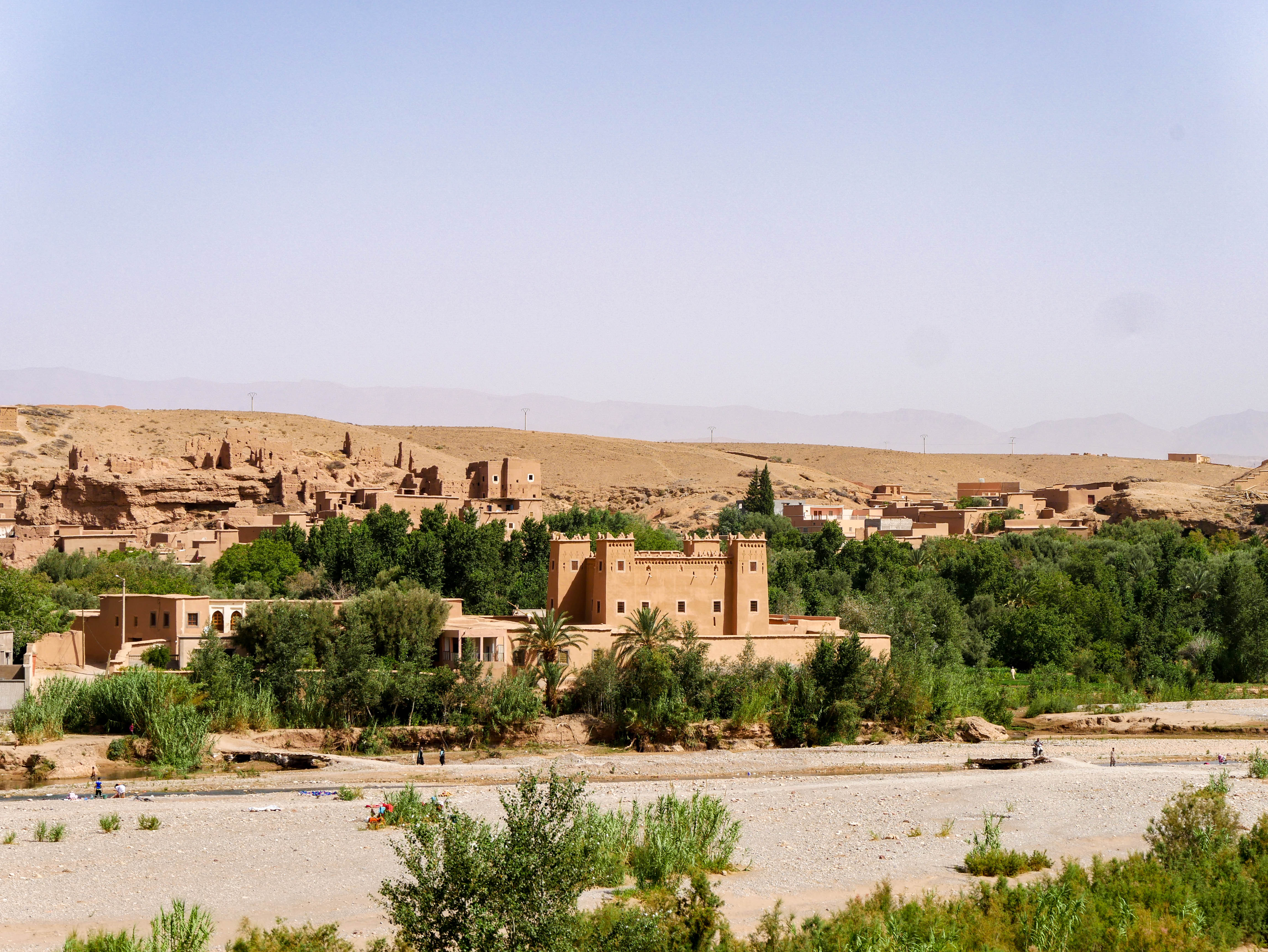
Our next stop at was at Morocco’s “Hollywood” in Ouarzazate to take photos.

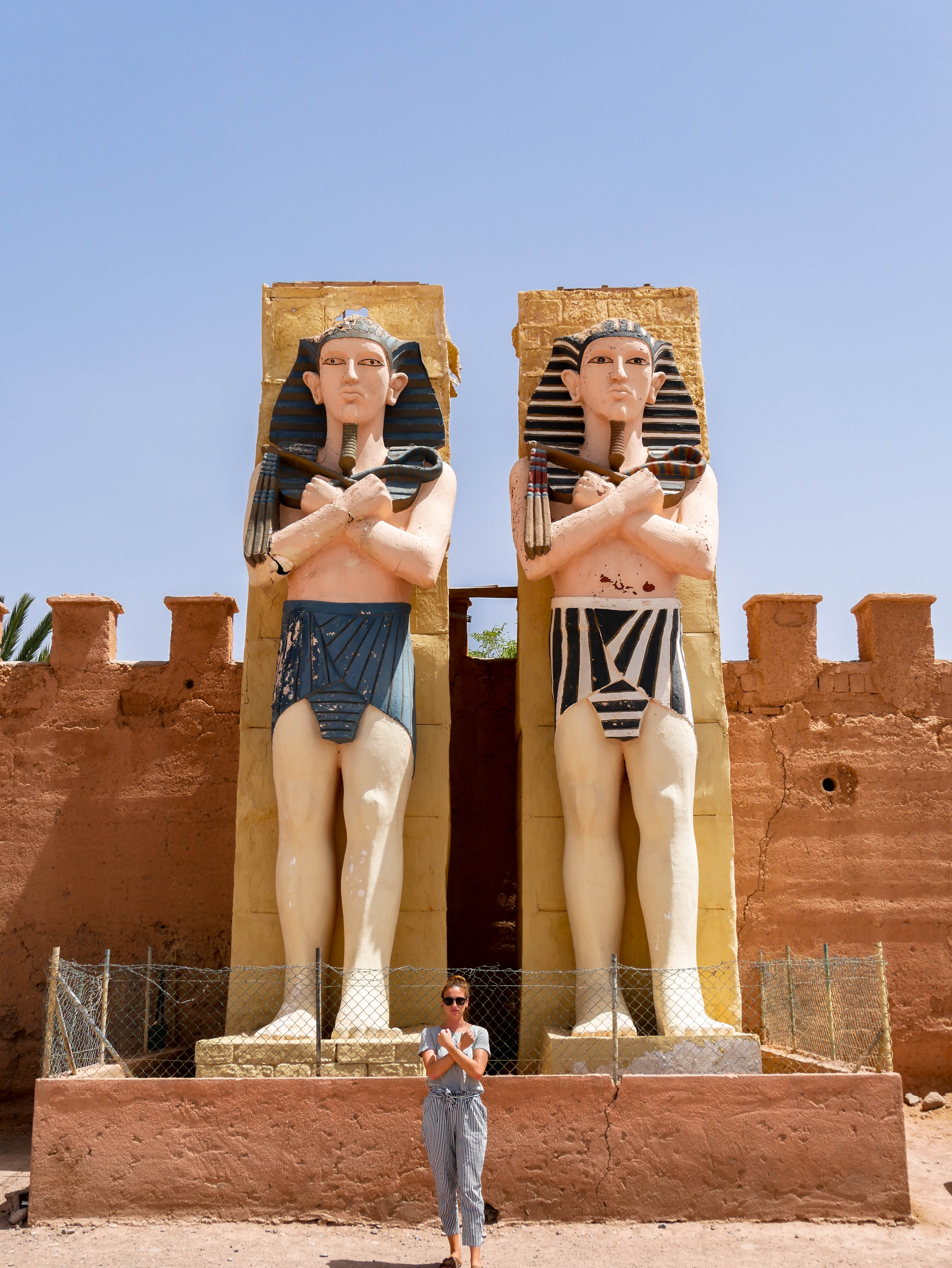
Then we arrived at the UNESCO protected the site of Ait Ben Haddou, where we had a local guide take us on a private tour. The village was absolutely gorgeous, although we were roasting in the heat of the day. Aside from being immaculately preserved, it was also where the Gladiator was filmed (among many other movies, and most recently Game of Thrones has been filmed there). I had never seen the Gladiator, so Matt and I watched it later that night in our riad.
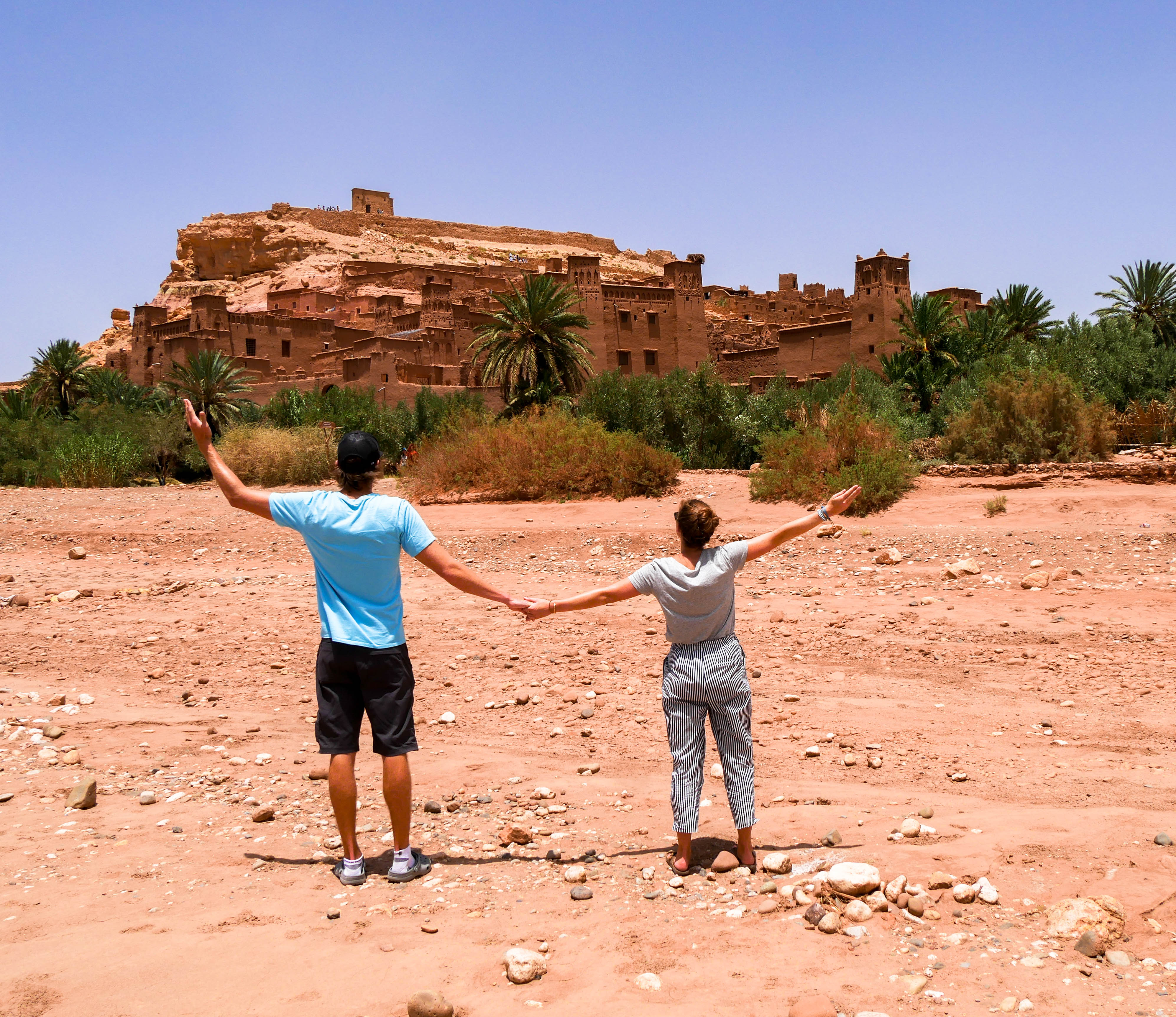
Six to eight families still live in the town. Since we visited in the summer, there was no river surrounding the village. A few years ago they built a foot bridge that crosses the river in the winter because in the past none of the village’s inhabitants were able to leave while the river flowed. Now the inhabitants are able to come and go from the village year round.
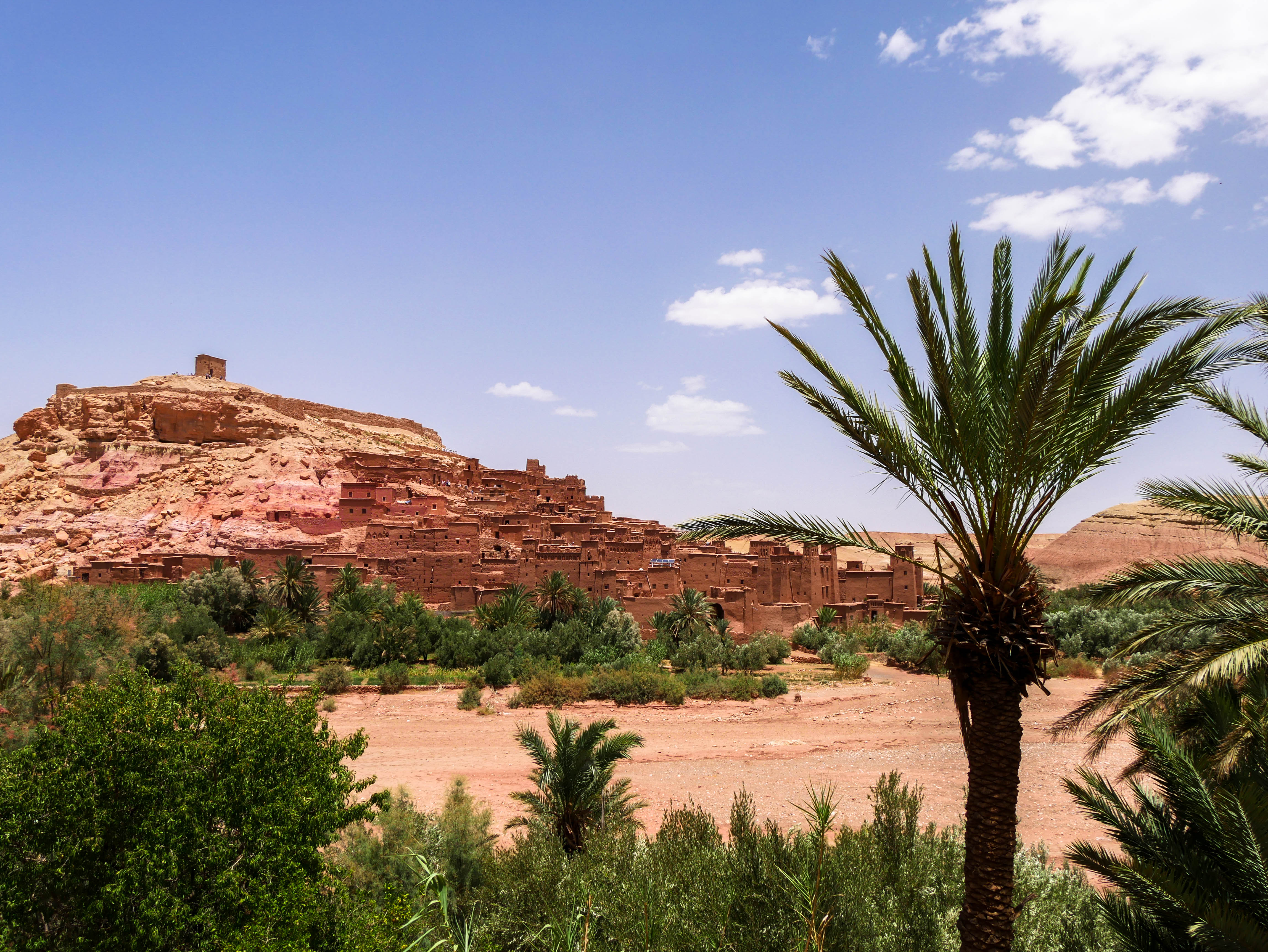
We ate lunch just outside of the Kasbah before driving through the Atlas Mountains again. We crossed highest road pass in Morocco, Tizni Tichka at 2260m high. Along the way, we witnessed impressive views of valleys, mountains, and Berber villages.
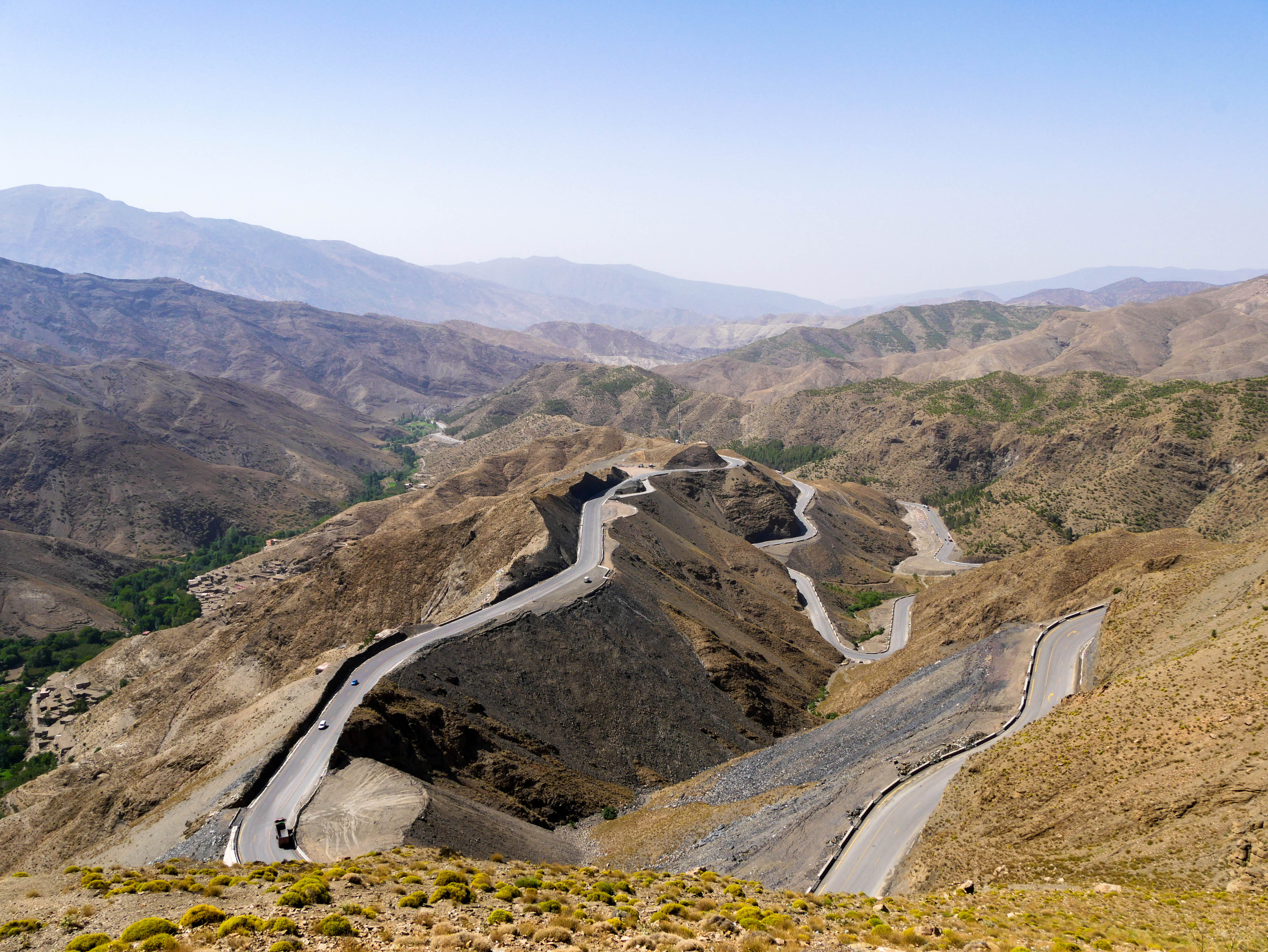
We took a pit stop at a female run argan oil cooperative. Morocco is famous for argan oil (used commonly in expensive hair products around the world). We got a demonstration on how different argan products are made, and I got to try my hand at contributing to making argan butter (which was delicious!).
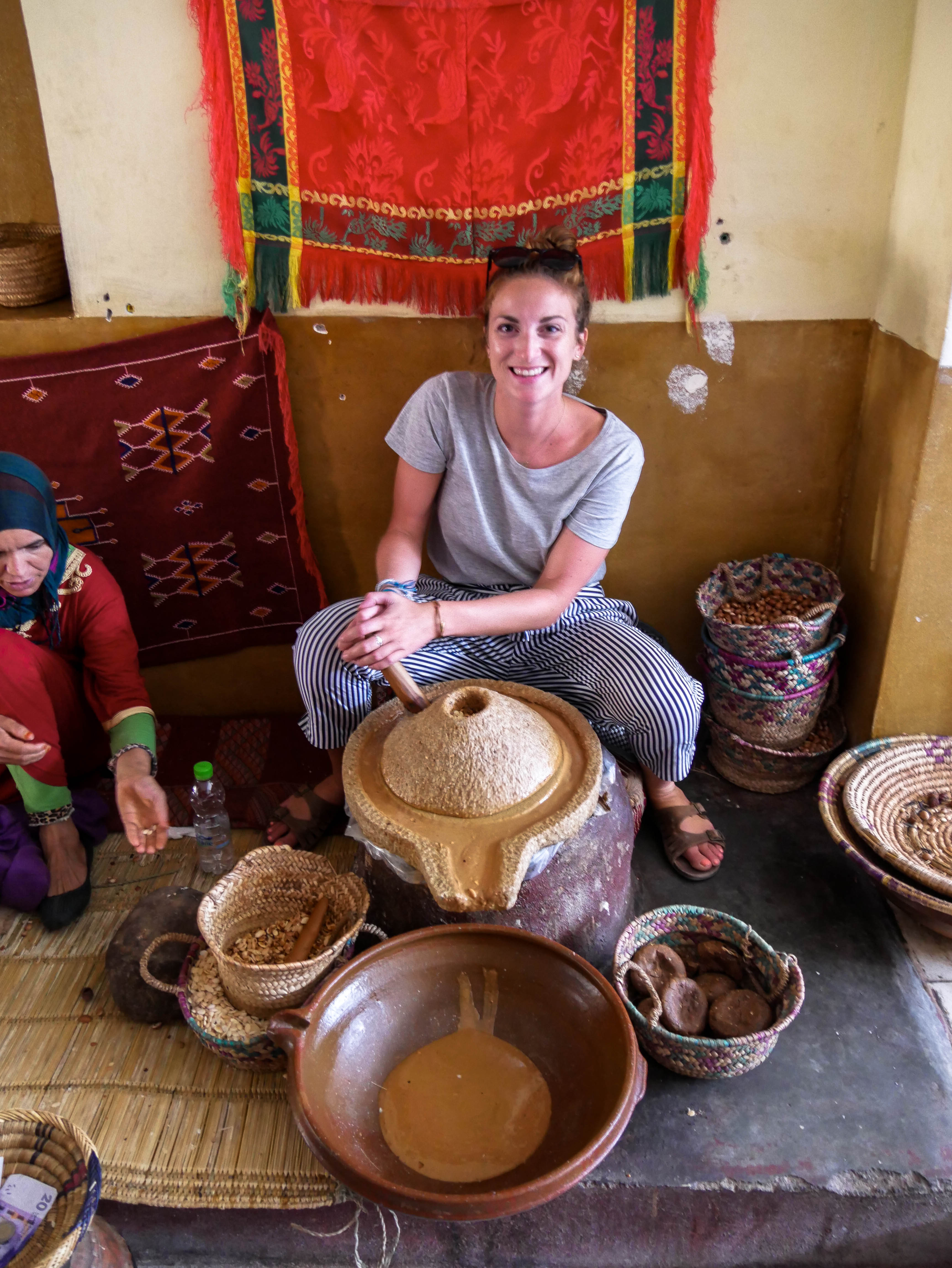
I wanted to buy argan oil for my hair, which was priced at 150 dirhams (roughly $15 USD) for 150mL in the store but the lady offered me 135 dirhams at a “special price,” which I countered with 120 dirhams (roughly $12 USD). She accepted my offer without batting an eyelash. Bartering is a big part of shopping in Morocco, and you are advised never to accept the first price you are offered (even if they tell you it is the “best deal,” a “special price,” or “Moroccan prices”).
Our scenic drive came to an end, as we were dropped off in Marrakech at our riad, completing our four-day trip with Morocco Camel Trekking.

Our verdict
We highly recommend Morocco Camel Trekking and believed the four-day trek was a perfect amount of time to take in all of the sites from Fes to Marrakech. Be aware there is a lot of driving involved, but you cover a lot of ground and can always let your driver know where you want to stop to get out and explore or take photos. All of our guides were kind and accommodating to our requests.
While we probably wouldn’t recommend visiting in the dead of summer (July) like we did – you do get the benefit of smaller/less?barely any crowds. Spring and fall will have less extreme weather, but with better weather comes larger crowds.
What’s included in the 4-day/3-night camel trek:
- Private tour in 4×4 vehicle or minivan with A/C
- Pick up and drop off in Fes and Marrakesh
- Driver/guide + Fuel
- Accommodation
- All breakfasts & dinners
- Camel Trekking & night in desert
- Turban for camel trek
- Sand boarding in dunes
*Full disclosure: By clicking any links we are not profiting from or commission from this blog post. In the interest of transparency, we received a small discount on our trek in exchange for helping Morocco Camel Trekking with their social marketing. We truly had a great experience with this company and have blogged candidly about our experience.



